#also this change in the script is entirely for the benefit of the viewer
Explore tagged Tumblr posts
Text
One Shots in Red, White & Royal Blue - Part 1: Alex's Room
Modern movies are fucking obsessed with jump cuts. Even scenes where it is completely unnecessary get cut to shreds. There's films I've seen where one, single sentence line got three jump cuts in it.
After watching Red, White, & Royal Blue over ten times now, I’ve noticed so many moments where they could’ve made jump cuts, but didn’t. There were moments where I was expecting it to cut because of how used I am to other movies cutting the shit out of scenes. They did not do that here, and believe me, it makes a difference.
Cuts temporarily remind the viewer that they're watching something scripted, professionally filmed, and edited. It's a subconscious feeling that most people probably don't even notice.
In case you're unfamiliar, a one shot in film is when a sequence happens without any cuts. One of the benefits of using them is the believability they add. Any amount of time could've progressed between cuts, like if they film a scene on two different days. When you see everything happening in real time, it just feels more real.
Red, White, & Royal Blue balanced their editing and camerawork incredibly well, and utilized one shots way more than I see a lot of other films doing nowadays. They use it for a variety of scenes, and it's done very well.
Example No. 1
From this moment, where Henry enters the room:

GIF by taylorz-nicholasg
To Henry pushing Alex onto the couch:
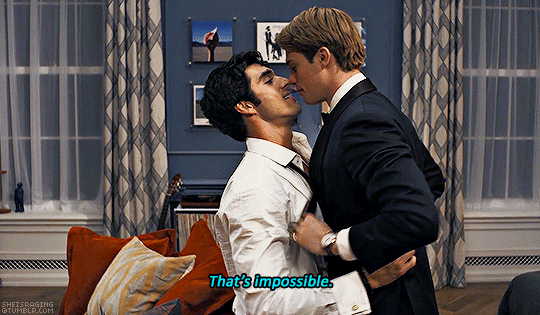
GIF by sheisraging
To when the sequence ends:

GIF by gay-bucky-barnes
is ALL ONE SHOT.
There are no camera cuts during that sequence, and there's a significant amount of movement and activity going on.
They are obviously aggressively making out, and crossing the room at the same time. Tracking this part might be common, but when they get to the couch, and Henry pushes him, I got this gut feeling that a jump cut was about to happen, but it didn't.
Instead, the camera rotates around to that side perspective, and lets Henry come back into frame and onto the couch in real time.
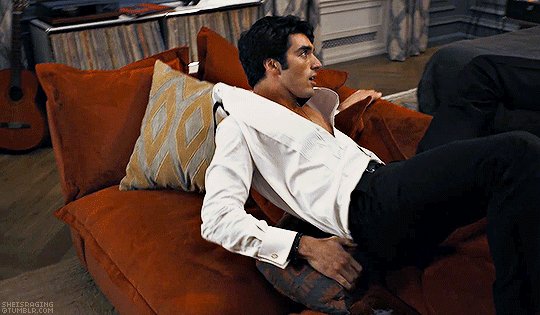
GIF by sheisraging
The camera doesn't change position until Henry moves down, which could've been a cut to Alex's face, but they opted to zoom in on him, keeping the shot connected.
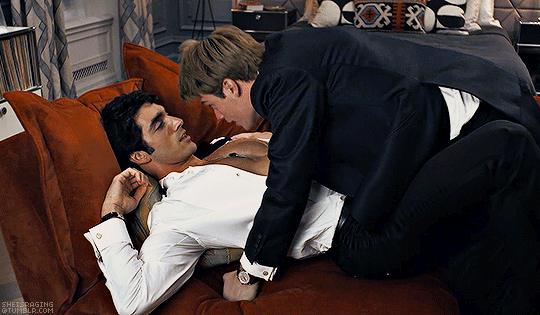
GIF by sheisraging
This is not a small series of events to capture in one shot, and it means that Nicholas and Taylor had to memorize and perform the entire scene's blocking as a whole rather than in parts. If they mess up, they can't just say: "hey try that line again"
A one shot scene like this means that if you mess up at any point during the sequence, you can't use the take. You have to do it again from the beginning. That's the point of a one shot.
I think it's such a testament to Taylor and Nicholas' talent, skill, and dedication that they did such a long shot involving so much intimate, and difficult, choreography.
Breaking it down, they have to kiss for the first part, but it's not just kissing; it's aggressive kissing. Their eyes are closed, and they're grabbing at each other, while crossing the room. Taylor has to walk backwards. They need to have really good spatial awareness in order to move without hitting something or tripping.
Once they hit the couch, Nicholas has to undo the buttons on Taylor's shirt. If you've ever worn a button-down shirt, you know that sometimes you just struggle with those damn buttons; there's a moment in Paris where they joke about them. Nick has to undo them fast, and deliver his lines too. If he's too slow with the buttons, or they get stuck, take ruined.
Nick has to shove Taylor onto the couch. He has to be visibly forceful, but not knock him down so hard he falls off the couch, or land in a way that make it difficult for him to shift into where he's supposed to be. Nick also has to climb around onto the couch fast enough.
Obviously once they're on the couch, the difficulty comes in that they are being intimate, kissing and grabbing each other, and they need to remain in character. Then they have lines, and Nicholas has to get even more intimate by kissing his neck. He undoes another button or two and kisses his chest and down his stomach, all while delivering his lines correctly.
If either of them messes up a line, or breaks character for a second, or loses their balance, or anything, go back to the start, do it all again.
That is so much, and the two of them nailed every part of it. I still admire how they were able to trust each other and become confident in doing all that they do.
This being a one shot created a really incredible scene. It's fluid, and grounded in space and time. It's not the only scene that's drastically improved by the fact that it's a one shot, so I'll probably write more essays breaking down those scenes cause this movie has me in a choke hold.
Update: If you enjoyed this essay & would like to support me, you can give me a tip on my Ko-Fi! ☺️
#red white and royal blue#rwrb#rwrb movie#rwrb thoughts#alex claremont diaz#taylor zakhar perez#nicholas galitzine#henry hanover stuart fox#firstprince
1K notes
·
View notes
Text
Delicious in Dungeon Anime Season 1, Episode 2 Review
Spoilers for season 1, episode 2 below the cut! There may also be mild manga spoilers so proceed with caution.
This episode was great! I think it was a big improvement on the first. Honestly no real complaints... I do kind of wish both Marcille and Chilchuck could have had stand-alone episodes dedicated to their character development, to allow for a deeper focus, but I understand why they didn't do it, and the pacing was still excellent. I do still sometimes feel like the show is in fast-forward at times, because with 3 meals in one episode, it feels like the characters finish eating, and we jump cut to them saying that they're hungry again, without anything to help really impress upon viewers that time has passed. Makes it feel a bit like we're reading a collection of short 4-panel gag comics instead of a continuing story… which, early Dungeon Meshi DOES have that as part of it's format, but it changes with time, as we get into longer individual stories.
During the Basilisk/Doni and FIonil section, I really do miss some of the dry humor from the manga. ("Hurry, he's getting cold!" "Move him closer to the fire!") The hilarity of slowly preparing a meal while someone is dying of poison has unfortunately been lost, which makes Doni and Fionil much less memorable characters…. But it benefits the other 2 stories in the ep to have more time so I think it was the right choice to make. It also gives people something to go back and read the manga for, since it's a little different! If you're reading this and you're an anime only, consider reading the manga while you watch the anime! I promise it's worth it. I'm excited about next week because I think they'll devote the entire episode to Laios and the living armors, which is me and my spouse's favorite early DM storyline, and the part where we both said "Oh, I LOVE this manga..." and got really invested. It's 2 chapters in the manga so it could be an entire episode…. which also would make sense, if that's why they needed to crunch 3 chapters into episode 2. Just like the first episode, animation was fantastic, and as usual the weakest points are when characters are just walking or talking and not doing much. Everything more dynamic is just bouncy and adorable and full of life. Very rarely is anything animated in a dull or flat way. They're doing their best to use "move a drawing around" or "zoom on a drawing" for comic effect and I think it's working well so far. There's some great animal animation in this episode, the bat flying around and the basilisk chasing Marcille in particular. Translation was better this time around, no dumb modern or game references in the dub ("newbs" "as if" etc.) … But there are differences between the subtitles and the dub script that change how easy it is to understand what's happening. When Senshi tells Chilchuck to cut up the giant bat, the subtitles make it hard to understand what he's telling him to do, and the dub makes it a lot clearer. In the subs when Senshi calls Chilchuck a half-foot child, the subtitles say "I'm not a child" and the dub says "I hate it when people call me 'kid'"… The latter is more interesting for keeping the mystery going for things that happen later in the story. If the show continues like this, I think the English dub may be the more satisfying way to watch it (even though the Japanese performances are great), mostly because the subs are very literal and sometimes miss things that the English dub somehow manages to include. And for some reason Netflix isn't including translation of Japanese signs on-screen during the subtitles, but they DO provide them when you watch the English dub. A lot of Dungeon Meshi's humor is sometimes in those background signs so completely missing out on them sucks. Anyway those are my thoughts for this episode! See you next week Meshiheads.
#dungeon meshi#delicious in dungeon#dunmeshi#my stuff#chilchuck#chilchuck tims#marcille donato#marcille#dungeon meshi spoilers#spoilers#anime#anime review#review
30 notes
·
View notes
Note
Saw this in my feed and while a lot of these are GREAT tips (especially the "plots should interact" one), the only thing I want to give an opinion on about this list is regarding the "don't double up on scenes" point.
Doubling up on scenes can be fine, but it should be establishing new information that's vital to the reader to know and, as OP mentioned, it should only be used when really necessary. Knives Out/Glass Onion does this incredibly well where knowing the other characters' recollection of the same events changes the entire narrative and acts as twists on top of twists. Knowing the other characters' perspectives of the same scenes is integral to the plot because those perspectives are vastly altered both by their own opinions as well as what they experienced during the events we had already been shown from another single perspective. The Perfection is also a movie that plays with this very technique in a very deceiving but fun way where you don't know who's trustworthy or what's really going on underneath the actions of these characters until the final act when it's all finally pieced together.
If you rewrite a scene from another character's perspective, it should be enough of a difference that it significantly progresses the plot or 'flips the script' in a way that benefits the story and what it's trying to say. If the scene plays out virtually the same way while establishing no new information or changing the viewer's perspective on what's really going down, then yes, you have a waste of a scene.
If you want an example of what you shouldn't do with other character perspectives, don't write Midnight Sun. Knowing Edward's point of view of the exact same story doesn't change that story, it doesn't add any new context that enhances the story in any way, it's just "Twilight but in Edward's head". If anything, it doesn't just fail to add new important information, but it makes the original story even worse (I mean, it wasn't Shakespeare before, but does knowing about Edward's creepy fixation on Bella on an internal level really improve it? It just further proves that the relationship in the original book was a mess and they're not worth rooting for LMAO)
What's your opinion on writing from multiple perspectives? Like, one chapter would be from Bob's POV, and then the next from Shirley's, ect. Do you have any tips for this?
I love multiple POV stories! I really like when authors explore multiple characters and really give the readers a chance to take in the story from many perspectives.
Multiple POV stories work best when:
You have many plots. The more complex the story, the more information you need to feed the reader for the story to work. Sometimes it’s just not possible to get all that information through a single protagonist. Many protagonists, however, are better suited to learning all that information. Many protagonists - especially if they aren’t working together - are also better at screwing up plans and creating chaos.
The plot is character-based. A character-based plot means the story deals more with internal struggles than external struggles. If your plot is character based, you really want to show the reader what all the major characters are feeling. Again, a single protagonist probably isn’t privy to everyone’s emotions.
Tips:
Your POV characters don’t need equal time. And when I say equal time, I mean in chapter time or wordcount time. Devote time to the most important characters and most important situations. Do as the plot demands, not as the character demands.
Don’t double up scenes. One of my least favorite moments in multiple POV stories is when the author covers an event with one POV character, then goes back to the beginning of the event to cover it again with another character. If you want another character’s perspective, let them remember parts of the event or revisit as little of the even as you possibly can.
Work on voice. You want to keep those characters as distinct as possible. They are different people, after all. I have a voice tag here to get you started.
Divide the POVs. Not with that awful fanfiction.net **KATNISS’ POV** paragraph starter. Divide POVs by chapter or put a little divider thingy in between POVs if you’re switching in the middle of a chapter.
Keep track of information. Your POV characters will not know the same things because they live different lives and will be exposed to different situations. If your POV character suddenly knows something they shouldn’t, you’ll have a plot hole.
Try to avoid one-shot POVs. One-shot POVs are when a character gets one POV chapter, then no others. There’s nothing wrong with it, but it feels strange to hear from a character once and then no other times.
The plots should interact. Even if the POV characters never meet, their plots should have a common element: for example, a common struggle, a common character, or a common theme. This prevents the story from becoming a collection of badly patched short stories.
3K notes
·
View notes
Text
What If AI Could Fully Automate Video Creation?

Imagine a world where AI could completely automate the video creation process—from scriptwriting to editing—without human input. How would this change the landscape of content creation? Scenario:
Picture an AI system that not only generates video scripts but also curates content, selects the right visuals, and edits the footage for you. It could produce videos based on trends, audience behavior, or even AI-generated narratives.
Analysis:
Potential Benefits:
Efficiency: AI could create videos in real time, keeping content relevant and timely. Cost-Effectiveness: Businesses could reduce the cost of hiring video production teams. Personalization: AI could tailor videos to specific audience segments based on data.
Challenges:
Creative Limits: Could AI-generated content lack the creative spark that human creators bring? Authenticity: Would viewers trust videos created entirely by AI, or would they prefer the human touch?
What are your thoughts on fully automated video creation? Do you think AI will replace human creators, or will it simply be a helpful tool? Share your ideas with us!
0 notes
Text
Calligraphy in Murals: Urban Art Revolution

Calligraphy in Murals: Bringing Lettering Art to Urban Landscapes
Calligraphy has become a powerful force in the world of street art, transforming walls into vibrant canvases that celebrate cultural heritage and challenge societal norms. In regions like Jordan, Lebanon, and Egypt, artists are incorporating the art of calligraphy into their murals, using it to create stunning compositions that captivate viewers. From hand lettering on walls to wall calligraphy, this urban art revolution is redefining the way we experience public spaces. The fusion of calligraphy and mural art brings together the beauty of the written word with the visual impact of large-scale artwork, creating a truly immersive and awe-inspiring experience. Join us as we explore the role of calligraphy in street art, the power of typography and lettering styles, and the influence of this art form on urban aesthetics. Discover how calligraphy in murals is reshaping the way we perceive and interact with the written word in our urban environments. Key Takeaways: - Calligraphy has found a new home in street art, adding a unique visual element to murals. - Typography and calligraphy in street art celebrate cultural heritage and challenge societal norms. - Street artists use different lettering styles to evoke specific emotions and reactions. - Collaborations between street artists and calligraphers create mesmerizing artworks. - Typography in street art tells powerful stories and influences the entire urban aesthetic.
The Role of Calligraphy in Street Art

Calligraphy plays a crucial role in street art, adding a unique visual element to murals that captures attention and sparks curiosity. Artists who specialize in calligraphy bring their skills to the streets, using their mastery of letterforms to create stunning works of art on a large scale. These calligraphy artists for murals combine the traditional art of writing with the urban art movement, resulting in captivating designs that blend aesthetics and social commentary. The fusion of calligraphy and street art allows artists to convey powerful messages and tell stories through their murals. The intricate strokes and graceful curves of calligraphy bring a sense of elegance and sophistication to the urban landscape. Whether it's bold and expressive letterforms or delicate and flowing scripts, calligraphy mural designs evoke emotions and make a lasting impact on viewers. Urban calligraphy murals not only showcase the artistic skill of the creators but also serve as a means of cultural expression and celebration. These murals often incorporate elements of local scripts and writing styles, paying homage to the rich heritage of the community. By using calligraphy in their artwork, artists create a deeper connection between the art and the people who inhabit the space. "Calligraphy is a form of visual poetry that adds depth and meaning to street art. It allows us to communicate messages of love, respect, and tolerance through intricate letterforms that captivate the viewer's attention. Calligraphy in street art is not just about aesthetics; it's a way for us to challenge societal norms and create positive change in our communities." - El Seed, Calligraphy Artist The Impact of Calligraphy in Street Art Benefits of Calligraphy in Street Art Examples Enhances visual appeal El Seed's vibrant calligraphy murals in Dubai Conveys powerful messages Hazem Qaqa's calligraphy murals advocating for social justice Celebrates cultural heritage Lebanese artist Karim Jabbari's calligraphy murals highlighting Arabic culture Challenges societal norms Egyptian artist Bahia Shehab's calligraphy murals empowering women The impact of calligraphy in street art cannot be overstated. It transforms the urban landscape, turning walls into canvases that communicate meaningful messages. Whether it's through vibrant colors, intricate patterns, or thought-provoking phrases, calligraphy in street art captivates passersby and encourages them to reflect on their surroundings. By embracing calligraphy, street artists are not only preserving a traditional art form but also pushing the boundaries of artistic expression. They are redefining the way we perceive and interact with urban spaces, inviting us to engage with their murals on a deeper level. Calligraphy in street art continues to evolve, inspiring artists and viewers alike to appreciate the beauty and power of the written word.
Typography and Calligraphy in Street Art
When it comes to street art, typography and calligraphy are powerful tools that elevate the urban landscape and captivate viewers. From modern calligraphy wall art to custom calligraphy murals, artists are using letterforms to create visually stunning and meaningful compositions. Typography and calligraphy bring an extra layer of depth and beauty to the streets, showcasing the artistic skill and cultural pride of the creators. With their unique manipulation of letterforms and handwriting styles, street artists create visually captivating murals that convey powerful messages. Playful and unconventional typography adds an element of surprise to the urban environment, transforming ordinary signage and lettering into whimsical works of art. On the other hand, elegant and intricate calligraphy evokes a sense of timeless elegance, showcasing the artistic mastery of the artist. Typography in street art goes beyond aesthetics; it also serves as a means of storytelling and political activism. Bold and impactful fonts demand attention, ensuring that the intended message reaches a wide audience. Street artists use different lettering styles to convey specific emotions and energies in their art. Whether it's conveying strength and power through bold letterforms or evoking tranquility through delicate calligraphy, typography plays a vital role in shaping the urban aesthetic. The Impact of Typography and Calligraphy in Street Art The use of typography and calligraphy in street art has a profound impact on the urban landscape. It transforms walls and public spaces into vibrant canvases that engage and inspire the local community. Typography in street art tells stories, weaving narratives that resonate with people and create a sense of connection to their surroundings. It merges the art of words with visual expression, creating a cohesive and art-filled environment. Moreover, the integration of calligraphy and typography in street art celebrates cultural heritage. Artists incorporate elements of local scripts and writing styles into their murals, paying homage to the unique identity of their communities. By using calligraphy in their art, these artists showcase their pride in their heritage and create a deeper connection between art and the local community. As street art continues to evolve, typography and calligraphy will undoubtedly shape the way we perceive and interact with the written word in our urban environments. With their ability to convey powerful messages, celebrate culture, and transform spaces, typography and calligraphy in street art are driving a revolution in urban art. Typography in Street Art Calligraphy in Street Art Transforms ordinary signage and lettering into whimsical works of art Evokes a sense of timeless elegance and showcases artistic mastery Conveys specific emotions and energies through different lettering styles Celebrates cultural heritage and creates a deeper connection to the local community Serves as a means of storytelling and political activism Brings an extra layer of depth and beauty to the urban landscape
Political Activism through Typography

Typography in street art is not only an art form but also a powerful tool for political activism. Artists who specialize in calligraphy create stunning murals with impactful fonts and lettering, demanding attention and conveying potent messages that challenge societal norms and ignite conversations. By strategically placing their art in public spaces, these calligraphy artists for murals ensure that their political messages reach a wide audience. In urban environments, where passersby are constantly bombarded with advertisements and signage, typography stands out as a means of making a statement. Street artists leverage the visual impact of bold and impactful fonts to draw attention to important issues, such as social injustice, human rights violations, and political corruption. By using calligraphy mural designs, these artists create visually stunning compositions that not only beautify the urban landscape but also serve as a catalyst for change. Urban calligraphy murals tell stories of resistance and resilience, conveying messages of hope, unity, and empowerment. Through their art, calligraphy artists inspire people to question the status quo, challenge oppressive systems, and stand up for what they believe in. By using their skills to express political activism through typography, these artists make a tangible impact on their communities and contribute to social change. Table: Impactful Political Typographic Messages Artist Mural Title Message Hazem Qaqa Revolutionary Dreams "Justice is worth fighting for" El Seed Voices of the Underground "Silence is the enemy of progress" Nadia Abu Nassar Breaking Chains "Freedom is not negotiable" Ahmed Shawky Equality for All "No one is free until we are all free"
The Timeless Elegance of Calligraphy

Calligraphy adds a touch of timeless elegance to street art, elevating murals into masterpieces that captivate viewers. With its intricate strokes and graceful curves, calligraphy brings sophistication and artistic mastery to the urban landscape. Artists like El Seed and Hazem Qaqa skillfully incorporate calligraphic elements into their murals, creating visually stunning compositions that leave a lasting impression. Calligraphy artists for murals employ various styles and scripts, each with its own unique beauty and charm. From Arabic calligraphy to modern calligraphy wall art, these artists showcase their mastery of the art form through delicate letterforms and impeccable craftsmanship. The combination of calligraphy and street art creates a harmonious blend of traditional and contemporary, resulting in awe-inspiring murals that stand the test of time. One particularly striking example of calligraphy mural designs is El Seed's work, "Perception." This mural, located in Cairo, Egypt, covers an entire building and features intricately written Arabic calligraphy. El Seed's careful choice of script and placement creates a mesmerizing optical illusion, where the words can only be fully appreciated when viewed from a certain angle. This fusion of calligraphy and street art showcases the artist's innovative approach and demonstrates the profound impact that calligraphy can have on the urban aesthetic. The Timeless Elegance of Calligraphy - Examples of Murals Artist Mural Location El Seed Perception Cairo, Egypt Hazem Qaqa The Beauty of Arabic Amman, Jordan Unknown Calligrapher Unity in Diversity Beirut, Lebanon These examples highlight the impact that calligraphy artists for murals can make on the urban landscape. By infusing their work with calligraphic elements, these artists create powerful compositions that both inspire and awe spectators. The timeless elegance of calligraphy in street art serves as a reminder of the rich cultural heritage and the universal beauty of written language.
Celebrating Cultural Heritage through Typography

Typography and calligraphy in street art provide a unique opportunity to celebrate cultural heritage and promote a sense of identity within communities. Artists who specialize in calligraphy have found a powerful medium for expressing their pride in their heritage and connecting with their roots. By incorporating elements of local scripts and writing styles into their murals, these artists create a visual representation of cultural diversity and create a deeper connection between art and the local community. One notable example of mural art with calligraphy is the work of artist El Seed. His vibrant and intricate calligraphic murals embrace Arabic script as a means to celebrate the cultural heritage of the communities they are displayed in. El Seed's murals not only beautify urban spaces but also serve as a reminder of the rich traditions and history that shape local identity. "Calligraphy in street art showcases the beauty of our cultural heritage and challenges societal norms by reclaiming public spaces with our own narratives." - El Seed Collaborations between calligraphy artists and street artists also play a significant role in celebrating cultural heritage through typography. These collaborations bring together the spontaneity and energy of street art with the precision and elegance of calligraphy. By merging their talents, artists create visually captivating compositions that pay homage to the cultural heritage of the community. The Intersection of Art and Culture Through mural art with calligraphy, communities have the opportunity to express their unique cultural identity and challenge dominant narratives. By incorporating calligraphy into their murals, artists not only beautify urban spaces but also create a visual language that speaks to the heart of their community. Typography becomes a powerful tool for storytelling, weaving narratives that resonate with the local population and foster a sense of belonging. Table: Celebrating Cultural Heritage through Typography Artist Location Key Themes El Seed Tunisia, France, Brazil Cultural pride, identity, unity Hazem Qaqa Jordan Arab heritage, resistance, social justice Sarah Al Abdullah Kuwait Feminism, Arab women empowerment
Playful Typography in Urban Spaces
https://www.youtube.com/watch?v=g5LkNYuUccA Street art has the power to transform ordinary urban spaces into vibrant and engaging environments. One aspect of street art that adds an element of surprise and whimsy to the urban landscape is playful typography. Artists use hand lettering on walls and wall calligraphy to turn everyday signage and lettering into artistic masterpieces that capture the attention of passersby. Playful typography in street art takes various forms, from colorful and bold letterforms to quirky and unconventional designs. Artists utilize different fonts, lettering styles, and sizes to create eye-catching compositions that engage viewers and spark their curiosity. Whether it's a whimsical mural featuring larger-than-life letters or a clever play on words that brings a smile to your face, playful typography adds an element of joy and creativity to the streets. "Typography has the power to transform the mundane into the extraordinary. By adding a touch of playfulness to urban spaces, artists ignite our imagination and encourage us to see the world around us in a new light," says renowned street artist, Lisa Johnson. The use of playful typography in urban spaces not only beautifies the environment but also creates a more interactive and engaging experience for the community. From interactive installations that invite people to become part of the artwork to clever wordplay that challenges our perception, street art's playful typography brings art to the streets and bridges the gap between people and their surroundings. Inspiring Words from the Streets Here are some inspiring quotes from street artists that highlight the power of playful typography in urban spaces: "Typography is like music for the eyes. It can create rhythm, convey emotion, and tell stories without uttering a single word." - Sarah Thompson "The streets are our canvas, and typography is our language. Let's paint the town with words that inspire, challenge, and bring joy to all who walk these streets." - Ryan Martinez "Playful typography is the antidote to the monotony of urban life. It reminds us that even in the hustle and bustle, there is beauty and creativity waiting to be discovered." - Jessica Nguyen Typography in Urban Spaces: A Visual Feast Artist Description A vibrant mural by artist Alex Johnson featuring hand-lettered quotes that inspire and uplift viewers. A stunning display of wall calligraphy by artist Mia Davis, depicting a whimsical poem that celebrates the beauty of the city. A playful mural by artist Jake Roberts featuring calligraphic lettering intertwined with colorful illustrations that bring joy to the streets.
The Impact of Lettering Styles
Lettering styles in street art have a profound impact on the overall aesthetic and emotional response that viewers experience. Each style carries its own unique energy and evokes distinct emotions, adding depth and meaning to the artwork. From bold and expressive fonts to delicate and flowing calligraphy, lettering styles play a crucial role in shaping the narrative and visual impact of street art. The use of bold and expressive letterforms in street art can convey a sense of strength, power, and urgency. These styles demand attention, ensuring that the message of the artwork reaches a wide audience. Whether it's a powerful political slogan or a call to action, bold lettering styles capture the viewer's gaze and leave a lasting impression. On the other hand, delicate and flowing calligraphy brings a sense of elegance, tranquility, and sophistication to street art. The intricacy of the letterforms and the graceful curves create a visual feast for the eyes, captivating viewers and drawing them into the artwork. This style of lettering is often associated with themes of beauty, spirituality, and cultural heritage, adding a timeless quality to the urban landscape. By employing different lettering styles, street artists are able to evoke specific emotions and create a multi-dimensional experience for viewers. Whether it's the boldness of typography or the elegance of calligraphy, lettering styles have the power to transform the urban environment and make a lasting impact on those who encounter these artistic expressions.
Collaborations with Calligraphers
Collaborations between street artists and calligraphers result in mesmerizing artworks that combine the spontaneity of street art with the precision of calligraphy. These collaborations bring together two artistic worlds and create unique compositions that captivate viewers. By merging their talents, street artists and calligraphers push the boundaries of artistic expression. When calligraphers and street artists collaborate, their different skills and perspectives complement each other, resulting in visually stunning and thought-provoking murals. Street artists, with their mastery of scale and composition, provide the backdrop for calligraphers to showcase their intricate lettering and script. The combination of colorful and expressive street art with the elegance of calligraphy creates an engaging and dynamic visual experience. Calligraphers often bring a deep understanding of the cultural and historical significance of their craft, infusing their murals with layers of meaning and symbolism. Read the full article
0 notes
Text
Anthy’s Sword Summon and Juri’s Fate: A Semantic Adventure
Friends, join me on a trip down the rabbit hole of discovery! While watching Utena with friends, as one does, I noticed that Anthy's opening to her sword pull sounded different than I was used to in episode 28, "Whispers in the Dark." The word 'omoi' appeared and I didn't recognize it from the shitloads of work I did on the musical. Confused, I figured I'd wait until the next episode, and see if I heard it wrong...and then, in episode 29, "Azure Blue Paler than the Sky"...she used the original line I was familiar with.
Uh-oh. Well this spiraled into an adventure. The facts, because of-fucking-course I went back and checked everything, are as follows:
Anthy’s sword summon in the Student Council Arc: 気高き城のバラよ。。。私に眠るディオスの力主に答えて今こそ示せ。 More or less: Oh rose of the noble castle, Power of Dios that sleeps within me, heed your master and come forth!
Anthy’s sword summon in the Akio Arc: 気高き想いの薔薇よ。。。。お願い、示して 。。。 More or less: Oh rose of noble feelings/sentiments/idunnohelpme...please, reveal yourself...
*EXCEPT* For episode 29,where her sword summon is: 気高き城のバラよ 。 。 。 お願い、示して More or less: Oh rose of the noble castle...please, reveal yourself...
This line, a blend of the different versions, is in the original and the remaster. Furthermore, based on how she says "please, reveal yourself," it's clear this was re-recorded to create this line, not just spliced from the different pieces of original audio. It's also worth mentioning that the Nozomi translation doesn't distinguish at all, and uses the phrase "Rose of nobility," for both arcs. If I'd known about this when they asked, I would totally have rallied to change this line, but whoops.
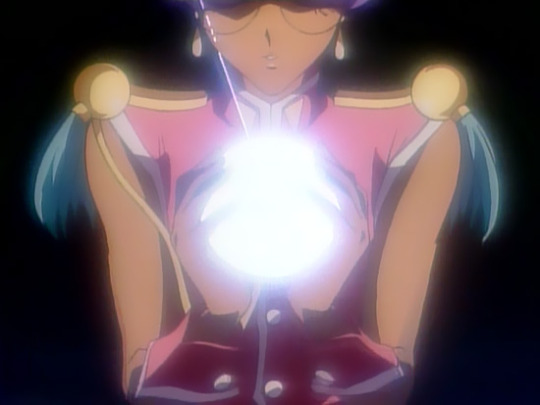
The change in the summon is not hard to rationalize. In the first arc, the sword is being pulled from Anthy, from the noble castle...from the illusion machine, to use a very old fandom term. What exactly she's pulling is the subject itself of a lot of debate. Is it her soul sword? Is it Akio's? Because Akio duels with a similar sword, though blackened, drawn from her chest. It's the sword used for all the duelists, it's the sword with the least intimacy. It's the sword used to direct the course of events, up to the point where Anthy rebels.
In episode 25, "Our Eternal Apocalypse," the Sword of Dios disappears, and against Akio's wishes given his reaction, Anthy draws a sword instead from Utena. Now she beckons to the "rose of noble sentiments/emotions/whatever, this is a hard phrase to translate," because it's no longer the castle, no longer the illusion machine, that is the source of the power she seeks. It's Utena herself. The "omoi" she is referring to is Utena's. In true magical girl form, this is a significant upgrade to the previous sword.
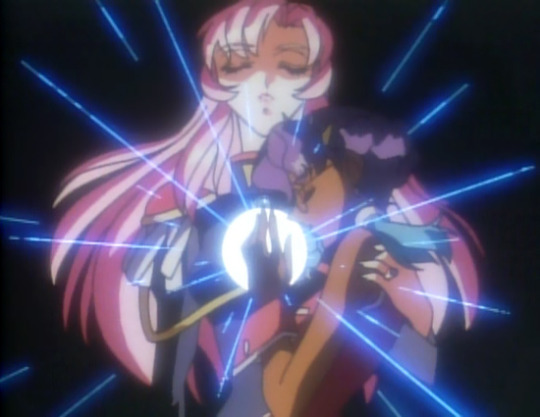
It's with this pattern set that the Akio Arc proceeds, until we hit a single, lone exception: Juri's last duel. The incantation changes. Just this once. Why?
Utena is handily undefeated in this arc; every time Dios comes down, every time she manifests the princely power her soul contains, she wins. Except this once. This time, her winning attack fails, just as it does in the first arc. Juri's capacity to deflect the Dios manifested attack follows from the obvious skill she has. It's never surprising in the context of the show that of all the duelists, she is the one able to successfully defend herself in that moment.
But this, that Juri successfully deflects this move, is the only thing that marks this duel as unique in the Akio Arc. It's the only thing that connects at all to why Anthy's sword summon would also, just this once, be a little different.
My theory? Though the sword pulled is still Utena's, true...Anthy has taken over command of this duel's outcome by calling not to Utena's noble spirit, but to the castle instead. The illusion machine. The means, whatever it is specifically, by which Akio and Anthy control the world of the duel arena. Because she is controlling, ultimately, where the sword is going to go. Anthy deliberately choosing to direct the sword to one end in this duel also implicates her as the reason why Juri loses her first duel, though that is made far more evident than it is here in the first place.
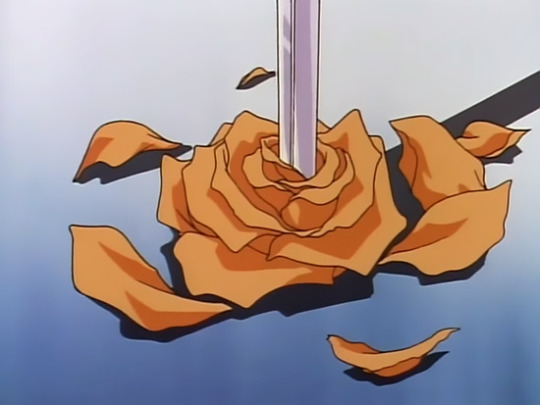
There are no miracles. But there are also no coincidences. There is only intent, and for Juri, it's intent turned against her. The wording of the summon in this duel is different, because the goal of this duel is different. The miracle that must be performed is different.
"Juri, she's a fool! She doesn't realize that you get miracles only by standing on the sacrifices of others! Yet miracles only come to people like her! Don't you find that unfair, Juri?!"
Ruka's intentions, and even who Ruka is referring to in this moment, are the subject of a lot of debate. I've always found it interesting that this dialogue works regardless of whether you assume he's talking about Shiori or Utena. Shiori seems the more likely subject, after all she's the person Ruka's trying to sever from Juri. She's the one he's angry at. But also, in his duel, Ruka sees Anthy seem to be praying for Utena's success, and he surmises from that that the Rose Bride is the source, at least partly, of Utena's ability to win. So, it can also be Utena who is the fool, standing on a sacrifice she hasn't noticed. Framed this way, where Ruka imagines the Rose Bride to be the source and the sacrifice that grants miracles, his placing himself in the position of Juri's Rose Bride is him willingly being the sacrifice he imagines necessary that buys Juri's miracle.
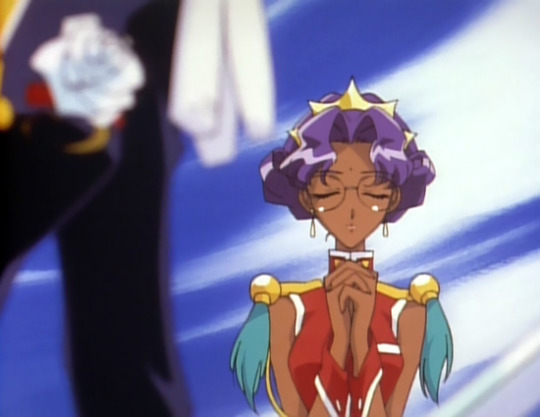
It's unfair, it's true, for a miracle to belong to someone unaware that a price was paid for it...but even as he says this, he pays in secret that price himself. Whatever transpired in the car, between him and, we'll say...the powers that be...decided Juri's fate without her input. It's why the outcome of this duel is made different, and it's why Anthy intervenes directly in the course of events to create that.
The Sword of Dios is a weapon wielded by Akio and Anthy, regardless of whose fingers are wrapped around the hilt. In episode 25, Anthy chooses to give up some of her control over events in favor of letting Utena defend herself and protect her. It's a sign of her growing trust in Utena that she lets Utena wield, literally, her own will. It's also a vote of no confidence in Akio and his plans, and it's why Akio is so pissed off about it. Letting Utena wield her own blade implies a trust in Utena to create the outcome Anthy wants. A trust it took her this long to grow.
However, in this duel, the goal has shifted. Ruka, for whatever reason, has intervened behind the scenes to create a different result, and that result cannot be left to the even minuscule random chance Utena represents. Anthy invokes the castle this time, because she wants absolute control over the outcome.

This may or may not be why the line is changed. It seems to me as good a theory as any, especially given how deliberately this is done. It doesn't shorten the sequence for timing. It's not a splice of existing audio. It's an explicit change made only for this one episode. It's the kind of minor detail, so easily missed, that really sends home to me why I love this show so much.
I, certified trash for entirely different characters, don't dip my toes into Juri's business much, I admit. I will, however, also be the first to say that Juri's duel episodes are some of the best directed and most powerful episodes in the series. They don't waste a single frame, their scripting is tight, their visual language both clear and almost a whole separate thing from the rest of the story. Little details like this utterly don't surprise me to find hidden here, in an episode where chairs shift and move. Where two duels happen at once. Where the color palette is made to reflect Juri's state of mind. Thank you, Revolutionary Girl Utena, for being the kind of garbage where a minor script change in a repeated sequence can lead to realizing Anthy straight up nerfed Utena for the duel.
PS. Fun thing we learned when trying to sort this all out: Yoji Enokido’s scripts for the first arc use a different phrasing than what ends up in the series:
薔薇の剣よ、私に眠るディオスの力よ・・・主にこたえて今こそ示せ 。 More or less: Sword of the Rose, Power of Dios that sleeps within me, respond to your master and come forth.
This line is included in Enokido’s script for episode 14, though it is not used in the series, because for the BRS Anthy doesn’t do this bit at all, it just goes straight to Utena’s “Grant me the power...” line. His script for episode 26 matches the line used in the series, but since he didn’t write episode 29, there’s no written record of this being deliberately different.
Additionally, one of the artbooks has the line “ Ô rose de nobles sentiments!” in it, which apparently has a totally different connotation to the English word 'sentiment.'
#utena#revolutionary girl utena#juri#Juri Arisugawa#ruka#rgu#sku#utena meta#anthy running the fucking show literally#yes i realize that akio and anthy still control the fate of the duels in this arc#Dios is literally a projection still#also this change in the script is entirely for the benefit of the viewer#and our dumb asses haven't noticed???
233 notes
·
View notes
Text
What U Watchin’ #6: Awkward (2011) IS The Best Teen Dramedy Of The 2010s.
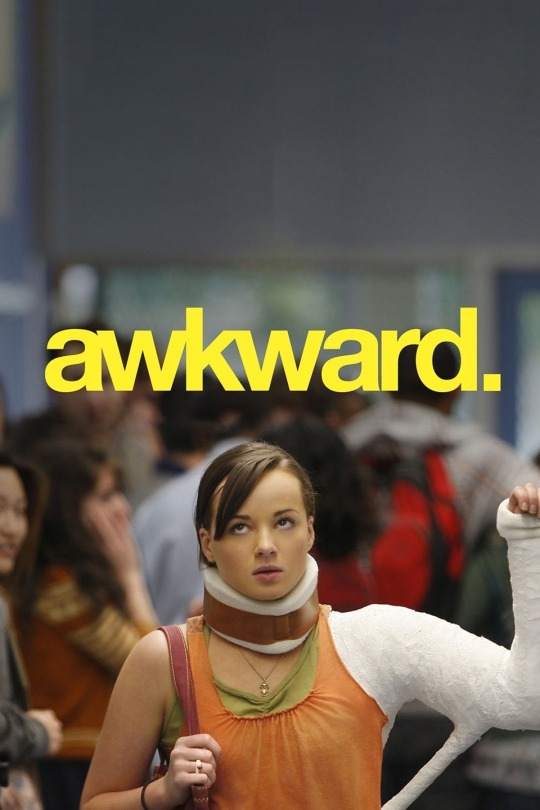
It’s the summer of 2011, The Real World is still premiering, pop culture is still evolving, and you suddenly see a promotion for a new upcoming MTV scripted TV show where a girl who supposedly tried to kill herself and becomes the laughing stock of school because of her unusual situation. Awkward was a teen drama comedy series that aired on July 19, 2011, on MTV. The series follows Jenna Hamilton who has a freak accident that was soon mistaken for a suicide attempt because of a ‘care-frontation’ letter telling her ways to be more popular and not a loser. She then begins a blog where she talks about her boy troubles, friendship issues, and peer pressure. The show went on for five seasons and had 89 episodes and the series finale was on May 24th, 2016.

As someone who has watched the show since its original air date in 2011 and rewatched it as an adult, I could comfortably tell you the source of Jenna Hamilton’s problems throughout the show. The source of Jenna Hamilton’s problems was Jenna Hamilton herself. In the first episode, Jenna loses her virginity to the school's IT boy Matty McKibben throughout the rest of the season he insists on keeping her his secret he figures out too late that he wants to claim her publicly. Jenna went along with it until she didn’t think it benefits her anymore. In the first episode, she also received the ‘care-frontatian’ letter that we figure out later that her mother wrote her. Jenna doesn’t see the letter as something helpful to her. She instead sees it as a cruel attack and she instantly starts crying. I probably was the only viewer at that time who thought that letter was necessary.

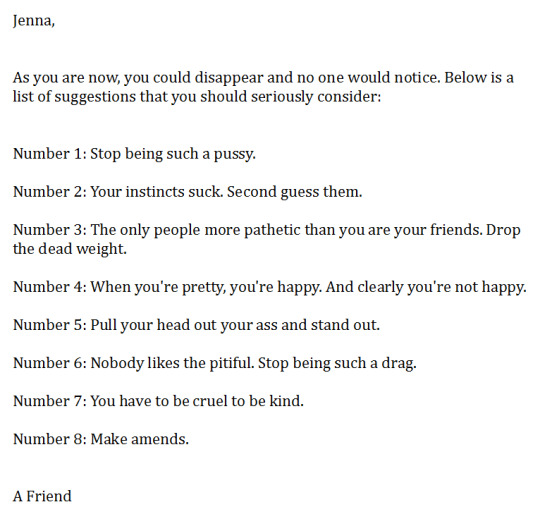
The first two ‘suggestions’ became reoccurring themes throughout the series, “Stop being such a pussy.” being first and “Your instincts suck.” which came right after. To say, Jenna Hamilton was spineless would be an understatement. Jenna would do anything for male validation and then turn to her family and friends when they previously told her, this isn’t a good idea. Jenna was very much her self-saboteur, and though she did have moments where she did have a spine, it was short-lived, and she went right back into her old behaviors that I hated. The letter probably was too harsh, especially what she just came back from but if her mother is noticing these things about her, I think that she’d wanted the best for Jenna but didn’t know how to go about it. Granted, the letter was harsh, but the weather was necessary for there to be change and for Jenna to evolve.
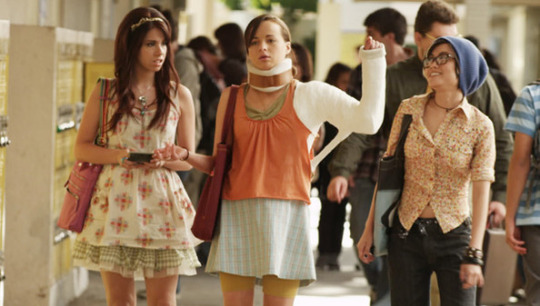
Having an amazing main character is one thing, but having amazing supporting characters that we fall in love with is even better. Awkward introduced us to the best ensemble cast throughout the show. Tamara was Jenna’s best friend and right-hand man throughout the show, she often gave Jenna advice and was a listening ear to Jenna, even when Jenna didn’t value what she was saying to her. Tamara was often selfless and put Jenna’s problems ahead of hers and frequently looked for her peer's approval and often tried to fit in the ‘in’ crowd. Tamara was a way better friend to Jenna than Jenna was a friend to Tamara and I’ll always die on that hill. Ming was also their best friend but she wasn’t given many storylines, Ming often was kept in the dark or the last to know what was going on in her best friend's lives but she still chased after the friendship with them and stayed loyal even though they did not value their friendship with her as much as she did with them.
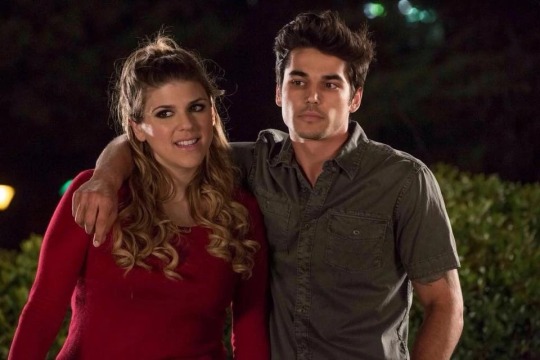
Awkward has also blessed us with the meanest yet likable antagonist in the series. Sadie Saxton was Jenna Hamilton’s nemesis throughout the entire series. They did something interesting with Sadie Saxton’s character, which was making Sadie a plus-size bully, who was also an IT girl. Sadie’s character was known for saying some cruel, but necessary truths to Jenna unprovoked. Sadie was Matty McKibbon‘s best friend, and often looked out for his best interest. Though she did speak her mind she was also observant of what was going on around her and often called out people when others wouldn’t. A lot of viewers often thought that Sadie projected her insecurities about being a plus-size teenager onto others, but I don’t think that was the case. Sadie was well aware that she was plus-sized and I don’t think she had a problem with being plus size, people would often project their feelings about her way onto her, which made her miserable in return. Sadie had no problem, making friends getting a boyfriend, or even academically. I think the characters around her didn’t like how confident she was while being ‘fat’. I’m not one of those people to act like the villain was misunderstood, but Sadie Saxton makes it clear that she wasn’t. Sadie Saxton was a bitch and she owned it and that’s what made people uncomfortable.
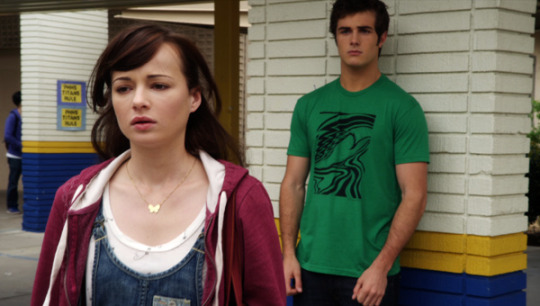
It wouldn’t be a teen drama without a love interest plotline that drags out the entire series. Does he want her? Does she want him? Do they want to be together? What happens after? These are often questions that we asked while watching Awkward between Jenna and many of her partners throughout this series, but she always went back to this one particular guy, Matty McKibben. Matty McKibben was Jenna’s main love interest throughout the series he was the guy she lost her virginity to, who was her crush, and he was her first love too. But a reoccurring theme over the series was if Matty was into Jenna, as much as Jenna was into him. Jenna was always the one making the first moves. While Matty would always disrespect her to her face, especially in the first season. Jenna was an embarrassment to him and I didn’t blame her at first for not wanting to be his secret this series Matty learn to accept her eventually, but I still think that he didn’t value her as much as she did him. There was one season in particular where Matty did go the extra mile for Jenna, but Jenna was an asshole the entire season and cheated on him with a guy she just met. Though the relationship had a lot of push and pull I never got tired of it. It was kind of enjoyable to watch who was going to ruin the relationship this time for who was going to chase after the other.

What I loved most about Awkward was how relatable it was. Awkward what is the formula of how to make a perfect teen drama comedies that didn’t need to touch on every sensitive topic but kept it lighthearted so the audience can enjoy. Awkward didn’t have social media cues that current teenage dramas do have. Awkward was the definition of fun, re-watching this show makes me realize that we don’t always have to keep talking about sensitive topics or what’s happening on Twitter to have a relatable show sometimes peoples issues only go as far as having growing pains, annoying parents, or relationship issues that aren’t abusive. TV used to be an escape from reality in people's actual shitty situations not amplified by writers who like to trauma dump onto the audience. Teen shows used to include drama and it would make the audience ’ooh ‘ and ‘ahh’ but nowadays it makes the audience run to Twitter with a think piece on ‘why XYZ character is wrong’ and make a 30-tweet thread about it to talk about for two weeks straight. TV was better when we didn’t have to have a conversation or add extra nuance to what we saw what we saw was what it was and we accepted it as it was.
What do you guys miss about TV? Do you like the extra conversations that we now have? What are some teen dramas that you recommend?

Awkward is available for streaming on Paramount+!
See you guys next post!

Cherokee💓
#whatuwatchin#awkward#mtv#rewatch#show review#show recommendations#black femininity#black womanhood#black woman#black blogger#blogger#pop culture#the real world#tvshows#teen drama#ashley rickards#beau mirchoff#nostalgia#nostalgic#2010s#one direction
27 notes
·
View notes
Text
ok that post of spike to the tune of p!nk's "get the party started" IS a shitpost make no mistake but im also thinking about litearlly how he does get the party started. i think what's insane about it is that in "school hard" literally every time he enters a scene it's treated like he is entering the show for the first time, like it's that level of fanfare every time. EVERY TIME he shows up it's this Event, it's like, oh shit!! this guy's HERE NOW.
1. crashing into the sunnydale sign "home sweet home" cigarette smoke blow etc
2. barging into the vamp factory, "if everybody who said they were at the crucifiction was actually there, it would have been like woodstock" / dru cheek blood lick / spikedru head swivel "me and dru, we're moving in"
3. appearing from out of the shadows at the bronze. *btvs shooting script voice* is it angel? it's not angel. it's spike.
4. appearing from out of the shadows in the alley outside the bronze, clapping, "you'll find out on saturday" "what happens on saturday?" "i kill you"
5. honestly when he's not even there?? in the library when giles is doing the spikesposition that will be the audio on every spike-centric previously-on, "he's known as william the bloody. earned his nickname by torturing his victims with railroad spikes .... he's fought two slayers in the last century, and he's killed them both" + angel being incredibly dramatic about him
6. barging into the high school through the broken glass "what can I say? I couldn't wait" :)
and i think what's also significant is that each of these introductions is for a different person's benefit??? like
1. the sunnydale sign crash is for the viewer's initial benefit like oh ok this is gonna be a Guy
2. and then in the factory it's to set up that a) he's going to be taking over as a new style of antagonist from the culty vampires, b) he's In Love With Drusilla and that's also literally going to set off just an entire new trajectory for what it meants to be a vampire in this verse, and c) that he's a narrative foil to buffy, with her also being this upstart disrupting the vibes of her ancient lineage and with Thee Iconic School Hard Red Cheek Stripes
3. is there to set up like not only is this A Guy but this is A Guy with narrative and emotional stakes in this world. like,, literally "it's not angel. it's spike" like i cant even talk about how INSANE that is. he JUST got here and already it's like oh ok lustful glances in the bronze he is embroiled in our sexy vampire trajectory interesting
4. HERE, after THREE introductions is finally the characters meeting him, like finally the people the show's pov is from are Perceiving him but we the viewer already have all this feeling attached to him, so when he shows up he has this narrative weight. like if the first time we saw spike was him clapping out of the shadows at buffy he would just be some guy?? but that first meeting gets to be pregnant with meeting bc of what we already know... spuffy said dramatic irony spuffy said tension between the fabula and syuzhet...
5. and NOW we get History. we get oh this guy is also embroiled in the LORE. he is narratively tied to slayers. he goes by many names. he is inducing weird psychosexual vampire tension in our resident broody vampire,, like something is Up. he's not just disrupting the Now he is literally embroiled in History. spuffy said all of time is always happening at once and the future changes the meaning of the past...
6. and THEN we get him bursting onto the scene. like this is the first time him and buffy are really interacting in a meaningful way where they are both equally active in their interplay, this is like, okay we have set up that this guy is going to Change Everything, and the Everything Begins Now, now we're in this dynamic moment of fighting and chasing and pursuing and Do We Really Need Weapons for This? ..... No Spike, It's Gonna Hurt A Lot .... now we've seen him introduced to all the ways he is altering the existing world we've set up, all the ways he's connected to and tinging the past, and now it's like, oh he's changing the present now. he's changing the future. he's established as a narrative symbol and the moment all that symbolism is fully set up he suddenly becomes a Narrative Agent, an Actor, A Character, a Being ... the way he is a signifier carrying around signifieds and then now it's time for those signifieds to live and interact with buffy's signifieds .... and interact they DO
#HIIII#btvs rewatch#COUNTING THIS for the rewatch tag bc spiritually i Did rewatch this episode today by proxy by being in there looking for screenshots#btvs meta
83 notes
·
View notes
Text
We hit 400 so here’s a- ✨ DREAM APPRECIATION ESSAY ✨
(by Yours Truly. Much thanks to the one, innocent anon who just wanted to ask a small talk question but hit my serotonin-providing hyperfixation.)
1. Self-esteem
I love the way he’s confident in his abilities when it’s become such a “trend” to either be completely and utterly self-depricating about your own skills out of fear of being labelled an asshole or overconfident nowadays.
At the same time you can still tell he doesn’t want to pull anyone down ever, and will always be really careful with that and take every oppertunity to lift up the people around him. Dream has a very emotional voice that gives him away a lot, so you can really tell he genuinely admires the people around him and he’s never afraid to say that they could totally easily beat him in something if he doesn’t have practice with it.
He tends to be a bit too hard on himself, so his friends always encourage him in his abilities, and that’s just. So nice. He celebrates his victories! He gets so so excited and happy when he wins in the manhunts, and I think celebrating your hard-earned victories isn’t something that should be villanized.
He won, and we should KNOW by now that doesn’t mean he thinks he’s somehow better than everyone. He has a pretty good eye on his abilities, and that allows him to really use them to the max.
2. Morality
He isn’t afraid to change the game! His adhd picks out a Cool New Thing and he just goes, You know what? Why not! His adhd goes “do this thing repeatedly another 3847 times” and he’s like, yeah sure!
Nobody expected him to release a song, but he just went for it! He’s been speedrunning so much, but he isn’t afraid to stream it every day 5 days in a row for hours while his friends bicker in the background.
Dream genuinely does the things he finds fun, but at the same time puts in so much effort to make them good and entertaining to watch and never forgets about his viewers.
He’s kidfriendly because he wants to be! Fame-wise, at this point he could definitly swear more if he wanted to (and he does when in other people’s content who don’t care about swearing), but despite that he doesn’t swear on his main because he wants his content to be accessable for everyone.
Sure, on one hand it could be for clout/money, but consider: Dream doesn’t stream the DSMP because he doesn’t want to take attention away from other people. He participates in the videos of his friends. He lets compilation channels and the like do whatever they want and even monetize his content. He lets his friends stream Road Trip on twitch as much as they want for free.
Dream doesn’t not swear just for his fanbase, but he does it because he has so so much respect for people. No matter how high he goes, he’s always consciously focused on respecting and admiring the people around him.
He has genuine respect for creators so much smaller than him, and he has respect for people in his fanbase that are younger than him. He isn’t afraid to go against the norm and STAND for that, either (see the video where he defends his stans).
And he defends his friends so much too! So much so it could almost be a little bit of a flaw sometimes, but I feel like he truly wants to learn from his mistakes. He apologizes for things even when nobody asked him to, and that just shows that he does it out of genuine guilt and fear of hurting someone.
He’s always seemed like someone who is genuinely willing to change to be a better version of himself, who isn’t afraid to challenge what he thinks and what other people think and what the norm thinks in order to improve everything for everyone.
Dream also doesn’t let any of the fame get to his head! As I said before - he’s confident in the things he’s good at, but in a way that doesn’t pull other people down, and he still remains firmly admirable of other people.
And even when OTHER people let fame get to their head (it was a while ago, but there was a video he made about five block jumps, where he added in a clip of a video of another guy doing it complete with credit and link etc. The guy was 100% alright with it at first, but when his video started getting more views because Dream’s video blew up, he started accusing Dream of “stealing” his content (when dozens of other videos of the 5 block jump already existed, and Dream could’ve just put in a clip of himself doing the jump)),,, but he insisted in his reponse that fame gets to people’s heads sometimes, nobody should blame anybody, he genuinely was never upset at him and just said that this just... happens sometimes.
He’s a very forgiving person all around, in part due to being willing to challenge his own norms and give people the benefit of the doubt JUST in case he’s wrong. He lets people enjoy things so long as they aren’t hurting anybody, like allowing people to ship him w people who are also alright with shipping, but at the same time taking a hard stance on, say, how shipping minors is absolutely wrong and should not be done ever (and he’s right).
3. Fandom
He appreciates said fanart and fanworks as well! He thinks dnf fanart is cool and he even appreciates the fanfic part of his fandom, something many ccs wish to ignore or forget it exists altogether (and it IS ofc in their right to do so or be uncomfortable with such content!), but Dream sees the work put into it and how people find connections and friendships through the fandom and appreciates it all the same.
He loves his fandom. So much. But not in the overdone, fake-feeling way I’ve seen other ccs be,,,, he’s just. Quiet and shy and genuine about it but not afraid to defend it.
He’s said before - and I QUOTE - “If you send hate to people or have sent hate to people, in the form of hateful comments or DMs, you aren’t welcome in my fandom. You’re no fan of mine”, which is the HOTTEST take he’s ever uttered and I love that. He really just went and said that. And he’s right. I like that despite how he’s usually more held back and waits things out before taking a stance, he chose this topic to really take a hard stance on and not budge and stick to it.
Pmbata has also said that he believes his fans have his back no matter what!! And that he really loves them a lot!!! And I am!! Emotional!!!!
4. ND/Adhd
He has adhd which is something I relate to personally (I have it as well sdlkfj). He gets excited sometimes!! I love how he shows being fidgety in mc, always pacing and parcouring around,, the way that in manhunts you can SEE when he’s thinking or bouncing back and forth between two options,,, or the way he gets close to people in mc to laugh with them.... He shows so much with his movements by them being quick and daring and calculated (and it’s especially hilarious to watch other people react to it in the video “mc but three people control one player”, where he’s the one moving and Sapnap and George will gasp or go “Dream!!” in surprise when Dream was THIS close to falling off a ledge, but he just laughs sdlkfjsdf).
When he’s not moving around he stands perfectly, perfectly still (which, idk if thats what all adhd ppl have, but I know I have something similar? Like when I’m nervous I’ll sometimes just. Freeze in place. No movement at all). He’s just relatable sdkjf.
There was one Manhunt extra scenes where he,,,,, stims by clapping,,,,,, the lil excited clap in the background,,, I’m gonna cry. I’m so soft for excited Dream that one is such a comfort clip for me!
He also tends to stim by getting under trap doors and then jumping back out of them, or jumping up a block and then walking back down over and over (especially noticable in The Village Went Mad tftsmp episode, where they were all discussing who the murderer could be and he was the only one moving, hopping up the log and then running back down again).
Also it is. Really Soft when he starts rambling and overexplaining something. What’s even better is that George, who is usually present at such moments, will laugh a little at his antics, and Dream will automatically laugh with him.
5. Rp/Uplifting other ccs
Dream wasn’t all THAT into the rp at first, but his server has been so strongly supporting and giving attention to smaller creators that he’s since completely rolled along with it. Being a villain in the RP is a difficult role because you will, inevitable, as much as it is just roleplay and all scripted, always get some amount of dislike from people for it.
Despite that, he’s basicly the main big villain on his own server where he let a bunch of theater kids beat him up in character and imprison him on his OWN SERVER. He wasn’t as into the rp at first, but has obviously been practicing and joins every Tales of the SMP when he can, despite getting zero clout for it.
What Dream also tends to do is find small content creators, see their talent and lift them high. His entire discord server is dedicated to give smaller ccs a place to grow, and when he first found Tubbo, Tommy, Ranboo, etc., they were much much smaller than they are now. He truly wanted to help them make it big.
He’s also added Foolish Shark and Hannah onto the SMP, both much smaller ccs (not tiny, but you get what I mean), allowing them to grow. He doesn’t stream on his OWN SERVER. He let himself get imprisoned to let the good guys win on his OWN. SERVER. He’s willing to play the villain and everything.
An interesting thing though! A lot of people used to/still do clown on Dream a bit for his sometimes uncertain acting,,, but when he’s around people he knows well (Sapnap and George, Tubbo and Tommy) we’ve seen him go ALL OUT. I have the theory Dream might be genuinely afraid to accidentally be mean to someone in character and have them misinterpret it sldkfjsdf,,, so he’s rly careful when he goes into the rp, and sometimes even when he’s in it he goes quiet, especially with other people around.
But also the fact that he needs time to feel comfortable around ppl is,, a mood,,, and adorable,,, sdlfkjsdf-
Apparently he’s also shared his youtube algorithm secrets with Tommy?? Which he had only shared with Sapnap and George before?? Dream took one look at that chaotic kid and immedietly adopted him as his little brother. He literally got up super early to rp the prison visit. Idk about ya’ll but I would die for someone first and get up horribly early for them second-
6. Friends!!
Dream?? Considers so so many people his friends?? And despite having so many friends, he also has his few closest friends (George and Sapnap) whom he would absolutely die for in a heartbeat. He WILL defend them with everything he has and loves them so so much.
He listens to them and really, truly wants them to succeed. He respects them so much and will go OFF about how good they actually are and how talented they are and how important they are to him.
I can’t even COVER everything about how much he is SOULMATES with Gorg. They live in each others heads rent-free. He mentions him all the time. They get!! So happy when they’re around each other!!! Their voices get so soft,,
And I can’t even BEGIN to explain the energy of Sapnap and Dream just moving together permanently. Imagine moving together with your best friend. Like, permanently. Into one house. They’re best friends Your Honor,,,,
Also,, remember the Techno and Dream rivalry? And Dream has recently said that he’s hesitant to make a serious manhunt against Techno because he doesn’t want there to be any feud between them or have them be compared to each other. He said that while he absolutely wanted nothing more than to beat Techno at first, now that he knows him better he just wants to be friends with him. He wants to be FRIENDS. With his, essentially, mc RIVAL. Friendly rival, but still. He doesn’t even wanna fight Techno or have ppl compare them cause he,,, wants to be friends with him,,,,
7. Vulnerability
What I feel like really sets Dream apart from some other ccs for me is that he’s willing to be vulnerable. He will tell George he loves him. He defends his friends. He sounds so, so genuine when he tells his fandom that he loves them.
What’s just really rare to see, especially in male ccs, is that vulnerability. It’s becoming more acceptable as time goes on, but it’s certainly not easy, and a lot of people become and stay long-term fans BECAUSE they can see how genuine he is.
I know Dream looks up to Mr. Beast a lot, for example, but honestly? I think he’s a little better than Mr. Beast. Because he feels more genuine, more bound to what he believes is right. I’m sure Mr. Beast isn’t a bad content creator! But ultimately they have different target audiences and I’m very glad Dream is the way he is.
Less of that insecure masculinity and more willing to be vulnerable, to care about things, to get emotional and to encourage and uplift the people around him.
8. Pure Brainrot
Green boi has nice deep calm soothing voice. Little shy laugh. Wheeze laugh. Gorg live in his head rent-free. He lov friends. He lov block game. He good at block game,,, a little shy but confident,,, big heart,,,, soft voice,,,,, rambles sometimes....
He also Gender. He’s so gender. I don’t know how else to describe it. I want That. Whatever That is. My gender is Dreamwastaken
#mcyt#mcytblr#dreamwastaken#dream#dream appreciation#long post#dreamteamspace speaks#space writes#yes this goes in my writing tag#this is Way too many words to only be in my normal tag#but how many dream apreciation essays have you written fear huh? Huh?? /lh#mr beast critical#adhd tw#adhd#just in case?
346 notes
·
View notes
Note
3,21 and 24 for the animation asks!
3) Name one cartoon series you never grew up with but felt that you would’ve LOVED as a kid!
Although I still don’t know a whole lot about it, I feel like I would’ve adored The Owl House had I caught it on tv as a youngster. I loved shows that revolved around monsters/demons so I could easily imagine myself drawing fanart of the creatures of the show obsessively in my sketchbooks, and I also vibe with whatever Eda Clawthorn’s got going on. The fact that show was openly queer is excellent! I really would’ve benefited from seeing that stuff in my cartoons...
21) How much has the medium of animation changed as you’ve grown older? Is there any era of it that you are most nostalgic for?
I’d say the biggest change I’ve seen in animation from my day is the rise in independent animation thanks to the Internet. Back when I was a kid Newgrounds was the only major hub of indie cartoons besides those who made their own websites for their shorts (this was before YouTube took off mind you). On tv you had to be very lucky for a station to show off your work, and if a viewer missed it than you had to hope it would get replayed somehow. Music videos were the luckiest in that regard; I can recall seeing some indie animation showcases on Nicktoons Network as a kid but those only aired once!
When it comes to mainstream animation, the one thing I miss the most was the variety of animation we had in the late-90′s and early-to-mid-2000′s. Back when Disney and Dreamworks were creating hand-drawn AND computer generated films one after the other, and when several shows experimented with multiple styles of animation (ex: Courage the Cowardly Dog, Code Lyoko, The Misadventures of Flapjack, etc.). It was also what I consider “the golden age” of animated documentaries, giving us great prehistoric docs left and right as well as excellent specbio classics such as The Future is Wild, Alien Planet, and Dragons: A Fantasy Made real
I don’t want to pretend everything was perfect in that decade (I do remember the writer’s strike after all...), but at the very least when taking mainstream animation into account it just felt more varied and creative compared to Disney’s regressive monopoly and all the generic crap Illumination keeps churning out
24) Gush over an animated film (feature length or short) that you find highly underrated!
L'Illusionniste (The Illusionist) is one of my favorite animated films AND NO ONE FREAKING TALKS ABOUT IT!!!!
It came out back in 2010 and was directed by Sylvain Chomet, the same guy who made Les Triplettes de Belleville which I also find to be underrated to some extent, though not nearly as much as this film. It’s a story told almost entirely without dialogue about a failing illusionist who meets a teenage girl while entertaining some locals on a remote Scottish island, who then stows away on his boat back to Paris because she thinks he actually has magic powers (and desperately wants to escape from that island). In fact, I learned recently that it was based off of an unfinished script from film legend Jacques Tati!
The animation is intricate and life-like, but also full of flair and intricate movement that live action simply cannot capture. While not as based in caricatures as Belleville it still has such a unique look to it; like an highly detailed sketchbook come to life. Such a sad, yet comfortable film. Highly recommend it!
5 notes
·
View notes
Text
My Brainstorming Process...

Argument: Children are not protected on YouTube
Project Proposal Video: A Deep Dive Into: Toxic Family Vlog Channels - Documentary Proposal
An educational deep dive into how family vlog channels can create a toxic living environment for their children would be useful in this generation. I argue that children are not protected by YouTube or possibly their own parents. This video would consist of scholarly research articles and personal research, delving deep into the facts and facets of both families. This video documents each point with reasoning (pulled from the family’s channels) to prove the argument. This video can help anyone with children or without children understand these harmful tactics some families use to earn a living.
A full documentary is being proposed for this subject, as online media is becoming more prevalent by the minute. Not many are reporting on this, and it would be an incredible introduction to the faults of new media and how they can affect children. It can shine a light on what people might not know or talk about…yet.
*This could turn into a docuseries, “A Deep Dive Into: [blank]” If we want to continue to talk about new generational issues that are recent and have a need.
Supporting elements are:
Flow charts with statistics of children on YouTube, families on YouTube, minors on YouTube, and engagement for each. Persuasive statistics.
Storyboard of both families & their other family members OR interview script?***
Background audio that is intense but inviting throughout the video
Lastly, viewing a unique piece of art by the author (me) that encapsulates the argument and main point of the proposal, generating passion and motivation for change. Some accessibility features and considerations that went into this proposal consisted of links in the description of the video, leading you to each source and its context, and social media links to both families, making it easily accessible to view the research on your own. PDF documents of supporting elements are also available on mobile or computer. This documentary would feature a brief mirage of new media, focusing on YouTube. How it has changed, what has evolved, what has stayed the same, benefits to creators, creator platform, sponsorships, and advertisements. There would be many shots of influencers, vlogs, crazy pranks, insane internet challenges, and more. We would go into a brief history of family channels and input the scholarly article research here. The second half, the most intriguing, would be a sit-down interview with the parents of both families. (You would have to watch the first educational part to get to the juiciness of the documentary). This Documentary Project would need:
Entire production team
Scriptwriters & a well-known, prominent interviewer
New media research, which must be thorough & cited
Documentary production team with an experienced director Co-director, audio team, visual team
Lights & cameras, on-person mics, and studio mics
Audio for each “scene”, sad, action, positive audio Audio specialists/team
Graphic designers to make the documentary virtually aesthetically pleasing to the viewer High res, HD, 480p, no pixels or virtual inconsistencies on mobile, TV, apps etc.
Prominent people who work in new media who have experience to share on how YouTube has changed or is changing
YouTube whistleblower? Or past employee experience? (doesn’t have to be negative but must support the argument)
Influencers on YouTube & interview them
Family Vloggers In-Depth interviews (The Ace Family or DadofFive) My Proposal Video Voiceover Video w/ video excerpts + my own analysis & narrated by me.
Describe the project (use brainstorming above) Family vlogging, toxicity, harmful environment, childhood trauma, negativity, Children are not protected on YouTube, Misleading information, harmful pranks, exploitation of children.
Entails: The Ace Family History (Brief) ▪ Who are they, where do they live,, and # of kids & ages? Names. Etc. (Crazy how much info I can find on this)….. ▪ What do they do (vlogs, pranks, house tours, etc. How they advertise for their other events to use their huge audience for $ opportunities ▪ Exploiting their children & their pregnancies (follow along with my pregnancy vlog, etc.) DadofFive History (Brief) ▪ Who are they, where do they live,, and # of kids & ages? Names. Etc. (Crazy how much info I can find on this)….. ▪ What do they do? (pranks, awful sad pranks, humiliation) ▪ Exploiting his children and their emotional state for views and money. ▪ Creating childhood trauma, children not being able to trust, feeling scared of parents, hectic environment (something is always happening), feeling like they are walking on eggshells (might get pranked). Other points: Children’s privacy/money Unnecessary trauma from “pranks” Added anxiety in the home Consent of children? Do they make $ since they are bringing in the views? Where does that $ go? College fund? Savings? Or do the parents use it/justify it?
2 notes
·
View notes
Text
CQL Rewatch - Ep 23

Seriously, how useless are these two right now? The puppets all dropped dead around them, yet none of them run up to help Wei Wuxian. I think we saw Lan Wangji running, but he just had dramatic close-up shots for the first few minutes as well. Like, stop looking dumbfounded and stop just providing facial reactions to things, and get up there! Act like you're in a war, gdi! They're reacting to seeing Wen Ruohan stabbed, which I chose not to cap for obvious reasons.
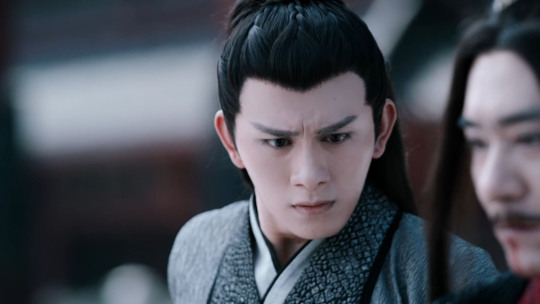
So even though I knew the story from the book, I still think this moment is pretty cool when they reveal that it's Jin Guangyao who has stabbed Wen Ruohan literally and figuratively in the back. The last time we saw him, poor Nie Mingjue was getting the crap beat out of him by Jin Guangyao, so seeing this here--like, ooh! Double-double-cross! Triple-cross!! It's fun to see a twist that doesn't make you groan! Because, of course, you want to root for Jin Guangyao because he's a bastard and has always been looked down on everyone. Now you see that he was not a villain at all, and he was actually helping the good guys by double-crossing Wen Ruohan! Of course, we know he really is a villain and all, but most of that really doesn't come until later in the story haha.

I do enjoy the light parallels here between Lan Xichen and his brother. We see both of them willing to give their best friends the benefit of the doubt and protect them from those who are less willing, let's say. And both of them are even willing to stand up to other people they know and trust. Nie Mingjue is one of Lan Xichen's closest friends, and we see Lan Wangji stand up to his own uncle. If you're looking at CQL without the romance angle (which, why would you?), this parallel is a bit more striking. You basically have two sets of bosom friends. Obviously one set crumbles at the end, but there are definitely a lot of parallels and comparisons to make. And sorry, for a show that couldn't have any gay characters, they sure made it seem like Lan Xichen and Jin Guangyao had a thing for each other (even though neither of them is gay in the book, mind you). A weird sort of change--I don't even ship them, but their early scenes seemed very shippy. Maybe it's my American lens, I don't know.
But speaking of weird changes, allow me to go on a tangent. Wen Qing's role expansion doesn't bother me, not really. I kind of say it does, but it's not really the expansion that gets to me. It's the fact that she was going to be a love interest for Wei Wuxian that bothers me. Wei Wuxian is gay. He's gay. Lan Wangji is also gay--if not gayer. Her being a love interest for either one of them means they are no longer gay. Bi, maybe, but what that would have done was erase their canon sexuality. It would have also turned their relationship into that horribly tropey brothers-in-arms or whatever name you want to give it--basically JUST FRIENDS who want to defend each other's honor. You can certainly read CQL that way, but if you are, I don't think you're paying attention to Wang Yibo's performance at all. And if you're not paying attention to the second lead, then why are you watching this show at all? So, changing their sexuality changes the whole show (which already is so tropey, from what I understand) into something so derivative, I wouldn't even want to bother watching it. One of the things I think you take away from CQL is Lan Wangji's, frankly, undying love for Wei Wuxian. If he goes and has a fling with Wen Qing at any point, that cheapens his character dramatically in my opinion. Lots of people can say this better than me, and probably have, but I'm very grateful to those passionate fans (and to Xiao Zhan and Wang Yibo) for helping to change the script from the original drafts, which were frankly no better than a junky harlequin romance, having Wen Qing passed around like a piece of meat, which is so far from her character in the novel, and definitely a disservice to her.

Not gonna lie, it's adorable to think that Jiang Yanli and Lan Wangji have been talking over the past few days, maybe having tea together, while Wei Wuxian is in a coma. I feel Lan Wangji was a very calming presence for Jiang Yanli, because she was probably very worried and fretful over Wei Wuxian. I like the idea of him playing the guqin for Wei Wuxian, and then having tea and a quiet chat with Jiang Yanli before leaving. Also very cute that Wei Wuxian is half-heartedly trying to badmouth Lan Wangji, by calling him boring and uninteresting, but he can't even get through the sentence without smiling to himself. Obviously he's loving the idea that Lan Wangji has been at his side every day, worrying over him and slowly doing his part to nurse him back to health.

I love his expression here: shock and relief and joy, all mixed together upon seeing that Wei Wuxian has woken up. Obviously he knew he'd wake up eventually, but he didn't expect it so soon and I don't think he expected his heart to be in his throat and to be so indescribably happy to see Wei Wuxian awake.

Wei Wuxian, of course, can't really meet his eyes, and Jiang Yanli makes a swift exit (she knows what's up--these boys need to talk). And Lan Wangji just has love in his eyes: Heart-guang Jun. I mean, imagine how he must be feeling right now. He had just gotten Wei Wuxian back from what seemed like certain death, finally reconciled, and then Wei Wuxian is in a coma! He must have been terrified of losing him again. It's probably all he can do right now to not hug Wei Wuxian.
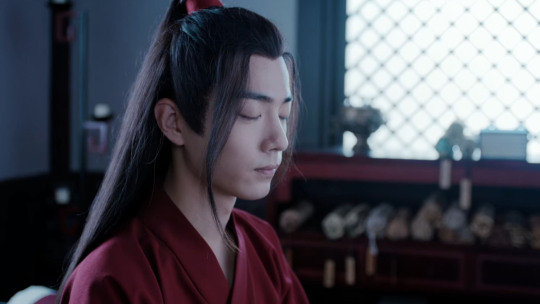
I seriously love everything about this scene. I love the colors, the cinematography, the longing glances Wei Wuxian gives Lan Wangji, the way Lan Wangji quietly scolds him while still playing the guqin because he's a professional. But really, I just find this scene very pretty and moving and emotional. I enjoy seeing Lan Wangji getting to take care of him and even more that Wei Wuxian lets him and puts up with it. I think most of us are quick to retort a good old, "I'm fine" when asked how we are, but in this case, Wei Wuxian is not fine, and he has no ground to stand on if he's trying to prove that. It's hard for Wei Wuxian at this point, though, to really lean on anyone, even Lan Wangji who is his best friend. He certainly can't lean on Jiang Cheng for reasons I don't think I need to go into again. He kind of leans on Yanli, but at the same time, he can't (and doesn't wish to) burdon her either. Lan Wangji is really the one person he should be able to lean on and seek comfort from, but he feels awkward and uncomfortable, because of the dark spiritual energy and giving up the sword, and Lan Wangji's crusade to help him.
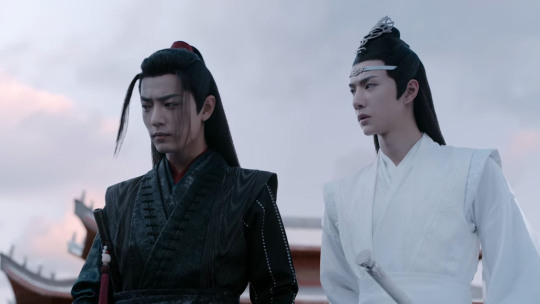
"Who is good and who is evil?" Wei Wuxian is struggling with a moral dilemma: is it right to round up the Wens and kill them/hold them captive? The Wens did horrible things, after all, and this is the reality of war. Of course, we've just seen Lan Xichen struggling with it as well. Why capture the women and children and elderly, who have nothing to do with the war? He's only met with the fact that it's not just the male cultivators who are dangerous. Still, his mind is only placated by the lie that the people will just be interrogated and sent to a labor camp--then cut to the blood on the floor. So Wei Wuxian is not only struggling with what the Jin Clan and other clans are doing, but he's also thinking about his own deeds--how many people did he kill? How many did he brutally murder in the name of revenge? Because of the things he's done, is he good or evil? Is good and evil so black and white? Does it just depend on whose lens you're viewing it through?
Lan Wangji looks at Wei Wuxian with all of this knowledge and doesn't know what to think. He's afraid of what Wei Wuxian has become, afraid he'll end up like Wen Ruohan--he's afraid of losing him entirely. But the situation is not black and white, and good and evil is not so easily defined. You can only know once you know that person's heart, and Wei Wuxian isn't really letting Lan Wangji in anymore. He's trying to convince him with his words, but that is simply not good enough.
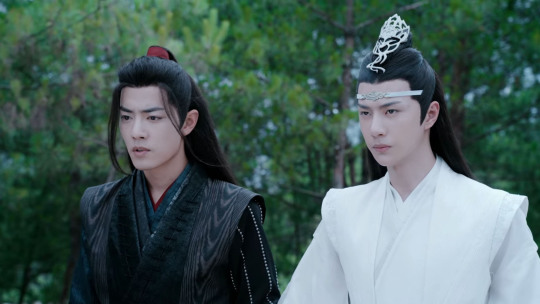
I think if Lan Wangji hadn't stopped him here, Wei Wuxian would have played that flute and tried to end all of the Jin "hunting party" (sorry, that was a little dark). His emotions were already high after the conversation with Lan Wangji on the cliff, and we've already seen him feeling disturbed by how the Wens are being chased and rounded up. I, for one, wouldn't have complained if Jin Zixuan's cousin bit the dust earlier. I think his name is Jin Zixun. Is that it? See, even I don't remember him.

I love how even though they are far apart, this scene still feels very intimate. It's very moving, and the music and the cinematography help to cultivate that feeling. I like how Wei Wuxian perks up when he hears Lan Wangji pluck the first few notes, and Lan Wangji does the same when he hears the sound of Wei Wuxian's flute. I feel like they are spiritually connected here as they play this haunting duet. And I think it's a connection they haven't felt for a long time. There has been so much tension between them for so long, and this scene feels like a big sigh from both of them. While I still feel like there is tension present, there is a bit of a release here--at least, that's how I feel as a viewer.

Ah, yes, the awkward period where Jiang Cheng has become leader of the Yunmeng Jiang Sect, wants to control Wei Wuxian, but doesn't know how. He's new at this, so I can't blame him for being a bit awkward as he figures out what he's supposed to be doing. As a young man, he basically nagged Wei Wuxian for doing inappropriate things, but now when Wei Wuxian misbehaves, Jiang Cheng is in part responsible for that behavior. At some point or another, the two of them grew up. Wei Wuxian's misbehavior isn't precocious anymore--it's serious and it has consequences, and just as in Gusu, Jiang Cheng sees that those actions are a reflection of the Jiang Clan. Only now, they aren't just a reflection of the clan, they're also a reflection of Jiang Cheng, himself, and his leadership (or lack thereof).
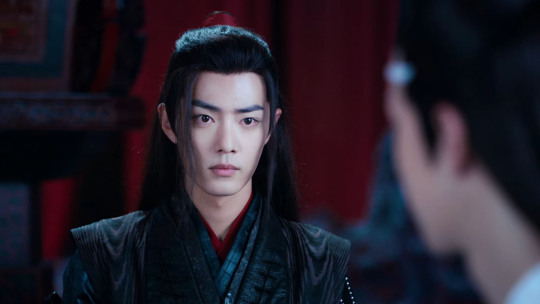
And speaking of awkward...Wei Wuxian and Lan Wangji have some...unresolved...stuff to deal with. But God forbid they actually talk right now. How can they? They're at this stuffy banquet that neither one of them want to be at. I feel for them both. Wei Wuxian is hurt because he thinks Lan Wangji doesn't trust him. Lan Wangji feels terrible because he wants to help Wei Wuxian, but the latter won't really let him in and allow him to do so. I feel myself just on pins and needles during these scenes with all these glances, but at the same time, I love it because DRAMA and ANGST! And they're just so in love lolol.
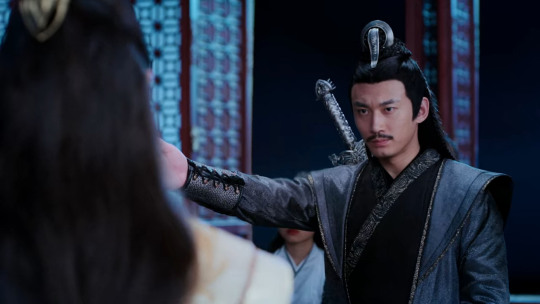
Nie Mingjue has to be that guy that always wants a certain table. The waiter leads him over and says, "Is this table okay?" expecting the answer to be yes, but nope--not Nie Mingjue. He'll request a different table. XD
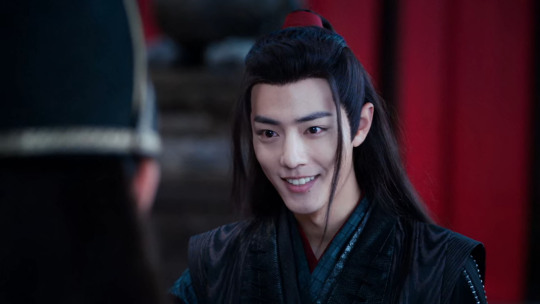
I love this little conversation--it's like they're both measuring each other up. I think they each have a healthy distrust of the other. Although Wei Wuxian has always been kind to Jin Guangyao, I don't think that discounts the whole demonic cultivation thing in his mind. He knows Wei Wuxian is smart and clever and, most importantly, capable. And as for Wei Wuxian, I don't think the ease in which Jin Guangyao manipulated Wen Ruohan is lost on him.Essentially the downfall of this great cultivator and enemy of all the other clans was due to one man: Jin Guangyao. I think Wei Wuxian is thinking the same thing I am: he's extremely clever, devious, and potentially dangerous if you get on his bad side. His rise to power within the Jin Clan is kind of amazing. His estranged father admits to Nie Mingjue and Lan Xichen that Jin Guangyao is his son, his station has improved drastically in a short amount of time. He sure as hell is dangerous.

Jiang Yanli can hardly contain her excitement when Jin Guangshan brings up her former engagement to his son. Just kidding, of course. I'm kind of horrified for her that he's bringing this up now in front of all these people. It feels very much like he's pressuring not only her, but also his son to get engaged again. First of all, Jiang Fengmian and Jin Guangshan agreed at the time to let the children decide whether they wanted to get married or not. Second, if you're going to talk about this, at least do it in private! Third, this is not letting the kids decide. God, this would be humiliating! And I also totally expected Jiang Cheng to speak for his sister here, so I'm glad he didn't do that. It's really none of his business either.
Lol! The weird cutoff here! Who's speaking??? I don't know!!! I mean, obviously, it's Wei Wuxian, but it's like they don't expect us to recognize his voice hahahahaha.
Other episodes: 1 | 2 | 3 | 4 | 5 | 6 | 7 | 8 | 9 | 10 | 11 | 12 | 13 | 14 | 15 | 16 | 17 | 18 | 19 | 20 | 21 | 22 | Or just check out the #CQL Rewatch hashtag
#wangxian#wei wuxian#lan wangji#theuntameddaily#cql#the untamed#jiang cheng#jiang yanli#wen qing#jin guangyao#lan xichen#ep 23#cql rewatch
19 notes
·
View notes
Note
Um one thing i wanna ask is why do you want penny to stay a robot? She would have been hacked again as it wouldn’t make sense for someone not to try it again... ignoring the pinnochio allusion thing cause of course RWBY shouldn’t follow fairytales like a script, but just thinking about practicality as the problem would just occur again.
Also, people complaining about how its a problem they cured her illness (having the virus)... why would you want her too keep the virus when its literally about to kill her and the cure is right there???? I dunno some of the complaints have me a bit confused and i need clarity on them.
Like, If they didn’t grab the relic for themselves, they would have been hunted by ironwood for penny, she would have been killed for the powers to open the vault etc... if they went to the vault with penny without their plan, she would have died... its all a lose lose for penny to me at least
Questions are genuine and I’m not trying to be rude or anything :)
Happy to explain, anon! :D
I’m going to break this up into three parts: The claim that people are upset about Penny’s virus going away, the idea that she’s in more danger as a robot, and the assumption that she had to be made human to fix this problem.
The first is the easiest to tackle simply because I haven’t seen any of this myself. I don’t know why someone would “want her to keep the virus when it’s literally about to kill her.” My guess would be that there’s been some miscommunication at play. I’m not saying just because I haven’t seen these takes doesn’t mean they don’t exist, but rather that I have seen a lot of critical takes since Saturday and they all boil down to the fans being upset that Penny’s android identity was removed, not that the virus was removed along with it. Of course we’re happy about that additional outcome, we just believe it would have been possible — even easy — to achieve that same outcome without taking a core part of Penny’s identity along with it (more on that below).
Secondly, if one of the main arguments for Penny getting a human body is “It’s less dangerous” then I personally don’t find that persuasive. Yes, it means no one can try to hack her again... but it also means Penny can die all the horrible, messy human deaths that she was previously immune from (within the boundary of how long Pietro can give her aura, anyway). We saw it happen on screen. Penny was able to go from this
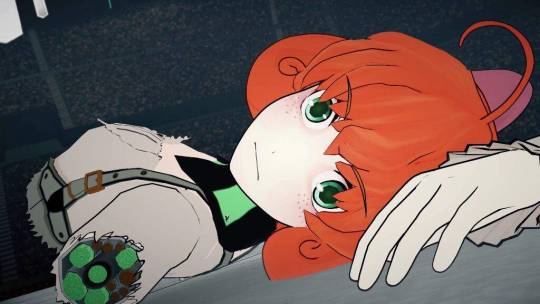
to this
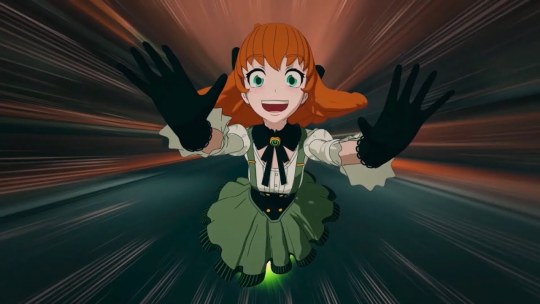
purely because she was an android. Penny, due to her synthetic body, was able to be torn apart and then — pretty casually it seems, based on Pietro’s comments — be put back together, given more aura, and booted up with absolutely no downsides. Penny shrugged off death with a smile! No human body can do that. So yes, she’s vulnerable to hacking as an android, but she’s vulnerable to everything else as a human, things like Nora’s scars and Yang’s lost arm, things that android!Penny would have shrugged off. Each body has its benefits and its downsides, with my personal belief being that, from a combat standpoint, a synthetic body has far fewer downsides and far greater benefits. But that opinion aside, objectively I don’t think a human body is intrinsically safer for Penny in the long run, especially not after her biggest moment in the series was coming back from the dead. She can’t do that anymore.
Which then touches on our third topic with the question: Why couldn’t the show have fixed android!Penny in a way that ensures she can never be hacked again? See, we have to remember that RWBY is a constructed, fictional story. Nothing “has” to happen. Or rather, nothing has to happen until the writers impose limitations on the text that the viewer expects them to adhere to. For example, if you impose the implied rules of 1. “Our four main characters will make it to the end of the series” and 2. “A character, without aura, will die from a spear through the gut,” then RWBY has to find a way for Weiss to survive Cinder’s attack (rule #1), but that solution can’t be, “Weiss is just randomly okay after a deadly injury, I guess” (rule #2). Hence, we get the solution of “Jaune unlocks his semblance and heals Weiss for her” and it works! It’s a solution that viewers like because it obeys all the rules, both overt and implied. Meanwhile, the problem with Penny’s solution is two-fold. The first is that it contradicts the entire journey she’s been on of “Android girl learns that she’s real and human just the way she is,” which I’ve already spoken about extensively (there are other posts on that), but the second problem is that the show ignores other possibilities and makes up new rules solely to reach this ending.
Why is Penny made human? Because of Ambrosius’ rules. Why do those rules exist? Because the writers said they do in this episode. It’s not that they introduced these rules episodes or even whole volumes ago, thereby requiring that they adhere to them once Penny’s life is suddenly caught up in them (like with the Jaune example). Rather, the viewer only learned these were limitations while Penny was being fixed. So the writers could have just... not included those. There’s no reason why, in developing Ambrosius’ abilities right then and there, the show couldn’t have made them into something a little different. Have Ruby go, “We want you to magic up an anti-virus program that will heal Penny completely, with no chance of the virus returning. Thus, when you create something new, it doesn’t matter if that program disappears. The virus is already gone!” If the response to that is, “But Clyde, Ambrosius can’t create something he doesn’t understand” that’s a rule that the writers just made up. No one forced them to suddenly impose that limitation. It was a choice. Or even if we have to have it for some reason, you’re telling that the group gets to have the schematics for their escape route — essentially inventing a teleportation system because Whitley looked at airship flight paths for a few minutes — but they can’t have Penny or Pietro draw up an anti-virus program? There’s no reason why these rules couldn’t have been tweaked to cure android!Penny.
There’s also no reason why Ambrosius needed to be involved at all. As just mentioned, Pietro exists and many fans (myself included) thought he would be the solution. Imagine for a moment we had a slightly different version of these events. Penny’s virus is briefly halted by Jaune and, finally given a moment to breathe, she asks where her father is. Last she saw, he was floating in a dead Amity after Cinder’s attack. This reminds Ruby that hey, Pietro made Penny! He’s just as smart as Watts and is far more knowledgeable of her systems. Maybe he can help? So the group heads to Amity and, due to the same techno mumbo jumbo that launched Amity in the first place, or had Klein heal Penny after her crash, Pietro says yes, he can get rid of the virus. Better yet, he can slightly redesign Penny so that she’s made un-hackable in the future, using (again, mumbo jumbo) parts from the now useless Amity. But it will take time. It’s then that the group receives Ironwood’s message and learns that they don’t have time. The reality that Penny will not be cured before the hour time limit necessitates that they come up with a creative way of dealing with Ironwood. Enter Emerald. Her semblance can make it seem like Penny is there, despite her being fixed by her dad miles away. We get an extended fight with Ironwood and, at episode’s end, the new and improved Penny catches up, ready to open the vault for them, this time of her own free will.
Now, obviously I just made this up off the top of my head — far from perfect — but a scenario like this:
Remembers that Pietro exists and lets him/Maria as an assistant do something for the plot
Re-uses Amity now that it’s just a floating pile of junk metal
Creates a scenario where we get to see Penny and Pietro confront the fact that she was created to be a tool (sorry I originally made you so easily hackable/put a self-destruct in your brain)
Maintains all the main story beats like Penny’s near escape, Ironwood’s message, and using Emerald’s semblance
Makes space to tackle other issues like the complaint that Ironwood was taken down too quickly
Achieves the desired result of healing Penny without taking away her android identity
Proves that, because we can easily come up with another solution, the idea that she “had” to become human is inaccurate. There were always other options
Hell, we can even ask why the story bothered with a self-destruct threat in the first place. Seriously, why did Watts do that? I have my own headcanons, but the show never says. This act is the entire BASIS for Penny’s conflict and the show didn’t bother to a) say why he’d do this or b) explain why he’d do this when Salem would presumably like having a Maiden to control. It’s counterintuitive and the show never grapples with that. We have no canonical answer here. More importantly, what else changes if Penny’s self-destruct order is taken out of the narrative? Absolutely nothing. She’s still hacked and struggles to keep Amity afloat, still flies to Ruby, still wakes up and needs to be calmed down by Nora, still tells Whitley her order, still fights the Hound, still tries to escape, still tells Ruby to kill her so she doesn’t open the vault, and Ruby still realizes that opening the vault might be the answer. They could have taken Penny to the door and nullified the virus by letting her do what the virus ordered. Penny is fine now, they snag the Relic, and the group proceeds to save all of Mantle and Atlas. The only thing this self-destruct sequence brings to the narrative is a reason to give Penny a human body. That plot-point was introduced solely as an excuse to give Penny a human body. That never had to happen. It’s not that the writers had a story where, by the rules already in place, they truly had to change Penny to ensure they didn’t lose her, it’s that the writers carefully crafted a story that existed to justify their desire to change Penny. That was always the end goal. They decided they wanted this to happen and that’s the problem here. That they took a character who has spent her entire, fictional existence learning to love herself as she is and crafted a bunch of unpersuasive, needless, and contradictory scenarios specifically to get Penny to a place where they could erase all that.
There’s no version of Penny that exists who truly had to get a human body to survive because Penny is a fictional character. Everything she does and experiences is thought up by our writers. Thus, at some point they thought up the idea to erase her android identity for a completely human one instead — the part a lot of people are upset by — and then made some messy attempts to write a story to justify getting that ending.
47 notes
·
View notes
Text
Unexpected endings: How 'Inside No. 9' tells a story
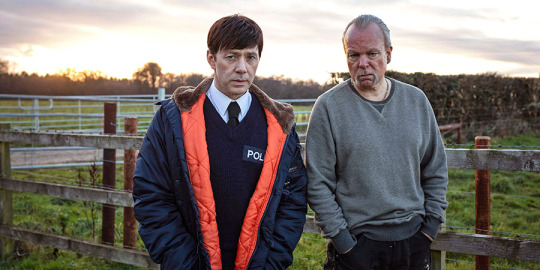
By Gonzalo Jiménez
The unfortunate consequence of any narrative formula is the predictability of its results. They end up boring and not very exciting. Undoubtedly, many producers and screenwriters resort to formulas because they offer the viewer familiarity and guarantee a result that can be replicated. But they sell out soon because the narrative twists are seen coming from a distance.
How can a formula surprise? Here is one of the benefits of television anthologies. In anthologies there is a main and dominant theme, which identifies the series and which must be evident to the viewer. But each episode has its own autonomy, with different stories, new characters, and even a different cast.
This different narratives is what arouses the surprise in the viewer. It is the key to evading the straitjacket of the narrative formula. This is perhaps the reason that explains how the horror genre and science fiction are the themes that have worked best in television anthologies, since their promise to the viewer is clear and direct: “come back next week, we will surprise you with a new scare". People already know what to expect.
Perhaps because it has not been discovered by the general American public, the British series Inside No 9 has remained a cult work outside of the United Kingdom. But it occupies, from our humble opinion, a place within the five best anthologies of world TV. Yes, its quality is worthy of being featured alongside The Twilight Zone, Alfred Hitchcock Presents and Black Mirror.
Behind closed doors
The creators of Inside No. 9 are Steve Pemberton and Reece Shearsmith, who write the scripts and star in most of the episodes. To date (August 2021), Inside No 9 has six seasons of six episodes each, to which is added a special Halloween episode broadcast in 2018.
In Spain, season 6 opens on August 31st, 2021 on the Filmin platform. In the United States, it can be seen on the Britbox, Amazon Prime Video and Hulu platforms. In the United Kingdom it is broadcast in an open signal on the BBC and streaming on iBBCPlayer.

What unites the different stories of Inside No 9 is that they all take place in a closed space, identified with the number 9. It can be a house, an apartment, a restaurant, a train car, an office cubicle or a karaoke room. It's a confined space, in which history is constrained by physical space.
But beyond the confined space in which the story unfolds, the key to Inside No 9 is that each episode has an unexpected ending. And Shearsmith and Pemberton have proven to be masters at this narrative device, becoming the television heirs to the unexpected turn and its main architects in the literary field, Roald Dahl and O. Henry.
Horror and humor
The tone of all Inside No 9 stories is black humor. Its comedy is terrifying, with fine references to British pop culture and the idiosyncrasies of the United Kingdom (I wonder sometimes if this is what alienates some American critics).
Most of the episodes are based on reality, betting on psychological terror, satire, suspense and crime, although there are seven chapters that address supernatural horror.
The originality of the stories imagined by Shearsmith and Pemberton never ceases to amaze me, how they manage to combine such different genres and situations within one season. His scripts are meticulously conceived, with an overwhelming logic and a wealth of language in which the dialogues fit like a crossword. Nothing is left to chance.
youtube
And what makes the difference are the unexpected endings of each episode. The entire repertoire of narrative turns makes an appearance in Inside No 9, although rarely in its pure state: anagnorisis (the revelation of the true nature or identity of a character, as occurs in Oedipus Rex or The Empire Strikes Back); the unreliable narrator, in which the narrator has manipulated or invented the preceding story, causing the viewer to question what he saw; peripeteia, which is the sudden (but logical) change in the protagonist's luck; the red herring, the non-linear narrative, and the reverse chronology (Memento-style, in which the story begins at the end and ends at the beginning).
Writer Flannery O'Connor wrote that "endings should be surprising but inevitable." Pemberton and Shearsmith have followed that advice to the letter and enriched it, as their stories display a deep understanding of 1970s British horror, in the style of Brian Clemens' Thriller series (1973-1976).
In Inside No 9 there is horror, but there are also very human and tragic stories that move and make us shed tears; there is also suspense and humor. There is social realism in Mike Leigh's vein, but also a scathing critique of acting awards; there is Folk Horror (so in vogue today), a silent episode and a chapter with the dialogues recited in Elizabethan verses.
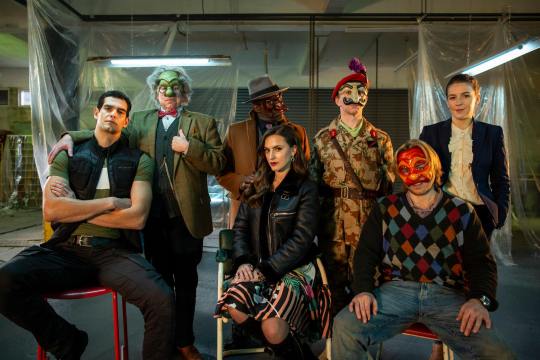
Inside No 9 is the evolution of Shearsmith and Pemberton, creators (along with Mark Gatiss and Jeremy Dyson) of the series The League of Gentlemen (1999-2017) and Psychoville (2009-2011).
The League of Gentlemen dominated the structure of sketches with recurring characters and was a brutal and perverse satire on the customs of a small English town, as if it had come from the imagination of the painter William Hogarth (1697-1764). The League of Gentlemen contains repulsive images but from which it is impossible to look away.
Instead, Psychoville has a more conventional structure as it shows the lives of five different characters --all bizarre and strange-- whose destinies intersect. Inside No. 9 will rescue two characters from Psychoville and include them in an episode of the fifth season but this connection is just a nod from Shearsmith and Pemberton, as the tone between the two shows could not be more different.
I suggest watching Inside No 9 in order, from the first season to the sixth, not because they are connected but to discover how the narrative concept of Pemberton and Shearsmith --who are also two extraordinary actors-- matured, how inventiveness and originality are sustained and increases. Inside No 9 is a perfect TV series for lovers of unexpected endings, meticulously crafted scripts, and memorable performances.
My favorite episodes per season are: A Quiet Night In (season 1); Cold Comfort, The 12 Days of Christine (season 2); The Devil Of Christmas, The Riddle Of The Sphinx (season 3); Once Removed, Bernie Clifton’s Dressing Room (season 4); and Love's Great Adventure (season 5).
#Inside No 9#BBC#TV series#Steve Pemberton#Reece Shearsmith#Horror#Anthology Series#The League of Gentlemen#Psychoville#Filmin#Youtube
13 notes
·
View notes
Note
you watching hdm brought back so many memories god they absolutely did the books JUSTICE and i am a firm believer in gay lee scoresby like please him and will's dad??? the TENSION the IMPLICATIONS anyway glad ur enjoying it!!
i am about to start a reread so i will wait to make up my mind on just how good it actually is but i do think they definitely at least did A Lot of it justice, although i am concerned about some of the choices in the first two seasons and how they are going to affect amber spyglass beats. but definitely leagues better than the film and, like i've said, while watching some of the choices and production elements were just. absolutely phenomenal and matched what i remember from reading the actual books, which is a testament both to philip pullman's capability of describing environments and characters and the production's dedication to representing them accurately. but it is also definitely flawed in places even uniquely from what i just mentioned about Choices
e.g. while they made it work in that it works for a coherent story in the adaptation itself, as an adaptational choice i'm.... less than enthused about the way they chose to represent the magisterium. i wouldn't go quite so far as to say it's hamfisted but imo they're beating viewers over the head with the totalitarianism rather than diving into what in the books i think was a very deft and delicate (while simultaneously absolutely scathing!) portrayal of the specific vehicles of control of faith-based institutions and faith-based authoritarianism, including the way that individual persons of faith "allow" themselves to be controlled by not just the organizing body of their religion but by their own faith. the magisterium in the tv series rules by fear. people are afraid of the magisterium. despite all the characters' talk of The Authority and shouts of "heresy", imo the show did not represent rule primarily by wielding the authority of god, it showed rule primarily by the power of government. in the novels, that is the power of the magisterium: wielding god against a believing populace.
even within jordan college, even with the pursuit of knowledge and the permissions granted by the concept of scholastic sanctuary, many characters, including lyra, actually believe in their religion! in lyra's world, people don't shout "heresy" just because they feel the need to pay lipservice to the magisterium. are they afraid of the magisterium? yes! but they're also afraid of the the authority, because they believe in the authority! they believe in the teachings of the church! they believe that heresy is an offense to the authority, not just an offense to the fascist power that rules their lives. there are notable exceptions, but they're exceptions.
imo presenting the magisterium to the viewers with the visual language of like, third reich germany, showing it as ~~Evil~ in an up-front objective way rather than an insidious-fabric-of-society way, showing its servants as having like the sole motive of controlling the populace for their own benefit rather than having the motive of pleasing and respecting an authoritarian god, skates past the point.
like in the novels is the magisterium meant to be evil? unquestionably yes! but representing that evil with the visual shortcut of IRL fascism rather than like... gradually revealing what/who the true enemy is in this universe... not a fan of that
like yeah in the show we get some characters, basically all of whom as i recall it are affiliated with the magisterium, having something like the fear of god in them, but like... it's not the same lol.
i just don't think that was effectively portrayed. and you know i'm sure a lot of that has to do with not wanting to provoke the irl religious populace significantly more than they inherently have to in making an adaptation of these books, because critiquing religious people is Quite different from critiquing a religious institution. and like okay that would be an irl constraint and i can respect it even if i don't like it, but i kiiiiinda get the impression that some of the people directly involved in this show were like, not really into that theme themselves.
and i can see why pullman would pragmatically compromise on that in order to bring forward what in most respects is a wonderful adaptation.
maybe i'll change my mind once i reread the books? my last reread was when i was a teenager and it's possible that it was this up front and just flew over my head and/or i forgot it
although having recently rewatched the first film, it strikes me as an adaptation that could have been great but was ultimately mired in outside forces' red tape in a way way way more obvious way — the good parts are really very good, you can tell that at points in the script there was a solid understanding of at least parts of the source material even if it isn't through the entire production, and i think the sense of it being so mild and sterilized for lack of a better word (as well as the ending which, don't get me started) and the tonal inconsistency is. intentional limitations from powers on high especially knowing how the production process went. sooooo many people feel threatened by this story and it reeeally shows in the film.
anyway you didn't ask for any of this but. you're welcome ajlkdsjfdsalkfsad
final note that actually addresses your ask: i definitely got Gay Vibes with those two from like my very first initial read and i'm still crazy about it like i'm crazyyyyy
10 notes
·
View notes
Text
hi, here's a short (long) analysis of this song which you should at least give a watch in my opinion! you might not like it, but you also might, so i say give it a shot.
anyways, here's my personal interpretation of the lyrics i (co)wrote. ani might have a completely different one, but you know.
beforehand, i need to point out that the first half of this was written before c!wilbur's revival and the second one was written after.
so, starting with the title

my motivation for it was c!wilbur's general role in shaping the narrative of the server, as well as cc!wilbur often joking around about scripts and other plot elements.
another thing was a clip of him talking with philza about how he thought the server's storyline was becoming very scattered, and i got the idea that maybe when c!wilbur comes back, he might try to rewrite the plot to his benefit as he has done time and time again.
hence, the idea for the song was born in my mind as i was falling asleep one night, because that is the only time i get good ideas.
the first half
"history, history, s'told by the winners, made by the sinners"
this was a reference to wilbur quoting the famous line "history is told by the victors". the reason i chose to use this set of words is because although the winners (wilbur) are the ones telling the story, the people who actually make the impact are often flawed, and genuinely invested in the cause (rest of l'manberg).
while c!wilbur knew the cause of l'manberg was false, he let the "sinners", or people he considered lower than him, since he was the one "telling" the story, win the war for him and make history as he altered the finished "story" in his own favor.
"so lie that you'll free them, s'long as you lead 'em"
this one is pretty self-explanatory. wilbur promised the revolution freedom in return for total loyalty to him, his power, and his country.
i'd also like to point out the use of "you" in this song - this was written, once again, before the revival; it was however expected that dream was going to bring wilbur back at some point. and i'm pretty sure ani doesn't know this, but writing this, i intentionally made the "you" wilbur is singing to be dream.
in essence, wil's telling his newfound ally about how powerful he is due to his abilities to "rewrite the script" - picture this being your usual villain monologue song after a dramatic return, since wil's always had a knack for the theatrics. keep this in mind for the rest of the explanation of these lyrics.
"the ink doesn't dry 'till time blows by spin a silver web and they're comply"
i absolutely loved this lyric, i couldn't stop gushing about it. ani came up with this one completely, so i don't know whether or not it has any deeper meaning, but i wanted to point it out because it sounds hella cool. the second part is about c!wilbur spinning lies until people would listen to him and do what he wants.
"smiles in the mirrors, reality's a game"
this line was meant to give an idea of just how screwed wilbur's perception of the world and people around him is, in that he treats everyone's lives as a narrative, as a symphony, as something that belongs to him and is free for him to play with.
smiles in the mirrors can be taken in a lot of ways, but one interpretation i like is that wilbur and dream as characters are parallels in their actions, but no one realizes it because the narrative paints them in different lights and the tragic hero and puppeteer respectively, when it's moreso the other way around.
"with help from the spinners we can shift all the blame"
spinners are the people wilbur uses to "spin" the tales for him. and, well, he's always been very good at shifting the blame and making himself out to be a victim.
seeing as he's talking to dream, in this line he is also reassuring him that he has people on the outside that can help them "rewrite" the current narrative and shift the blame away from dream and wilbur, in order to change the public's perception of them, which is at the time overwhelmingly negative.
"and if the world hunts you down out your mind and around we'll set their precious world adrift, adrift"
this is the most obvious pointer that wilbur is singing to dream. he is directly telling him that since the people of the smp have "hunted" him (or would, if he were to escape), and have hurt him mentally and physically in the prison, wilbur would work with him to destroy their lives and their world as they know it for their mutual gain.
it also brings forth his views of possession and power; in essence, he sees himself as in charge of the lives of everyone in his story, hence finding their realities fragile and fully his own to mess with. he finds it amusing that he has full control over something so "precious" to them, and mocks this sentiment in the last line.
"and if you don't like what's shown and you feel like no one's grown just, rewrite the script!"
this was the first lyrics for the song, which ani wrote, after i proposed the idea. this begins a trend in the song where wilbur will alternate between talking to dream and the viewers themselves.
here he is directly addressing those who don't like the way the smp has been since wilbur has stopped writing, and who call out the lack of character development in certain people's stories. he is reassuring them that now that he's back, he will rewrite it to be more entertaining - for him, that is.
the second half
alright, now we're going over what i myself wrote the day wilbur was revived after getting a surge of inspiration.
"screams, broken voices poor writing choices"
this starts off with revived wilbur's opinions on the new storyline he has come into. the first line refers to the torture dream is going through in prison, and the second is him simply commenting on how he finds the plotline inadequate after his return.
"dreams of redemption caught my attention"
the interesting thing about this is that wilbur, as has been shown before with eret, doesn't believe in people's redemption.
this line insinuates that even if there was any chance of the circumstances changing and dream getting better, now that wilbur was back, he wan't planning to let that happen, as he finds it one of the aforementioned "poor writing choices".
it caught his attention as something he finds interesting - since he's always had a twisted fascination with people's hopes and goals, finding ways to use them to his advantage - but in the end, naive, since his outlook on the world has always been quite cynical.
"train wheels screech on the rails in the end, my world prevails"
this was an attempt to shove a reference to the stream i had just watched into the song. the train stopped in limbo, and it came to get him back out to the world of the living.
the second line is him boasting that he knew all along that his efforts to gain people's loyalty would would pay off in the end, and hence his "word" prevailed even over death.
"i've got tales in store, of loss and of war it's a shattered world for me to restore"
see, this entire sequence is quite the oxymoron, and it's meant to be confusing, showcasing once again just how twisted wilbur's outlook on the world is.
he finds the story "shattered", which is a reference to cc!wilbur saying he prefers more centred stories than what the dsmp is right now. he is promising to fix this, finding it another game for him to play, another puzzle for him to solve, however, his definition of "restore" is proven by the previous line to be a contradiction at its core.
he has plans from his time in limbo, and just like all of his stories so far, they're tragic and traumatizing to the people playing in them. he plans to perpetuate war and conflict in order to make the story more lively and dynamic, while using loss as a tragic element to push the "characters" in their lives further towards development.
in the end, the way he's planning to "restore" the world is by rewriting the narrative in such a way that it wouldn't stagnate, or work itself out naturally, but continue endlessly for him to write and control.
"villains and heroes, traitors and moles when push comes to shove they'll burn the world for their goals"
the second part of the first line was meant to be "interchangeable roles" instead, but we switched it out so it would be easier to sing.
it's talking about how after all, it doesn't really matter to wilbur who the villain or hero is, as long as they are part of the narrative that he has power over.
"and if i harness the flame their hope will blaze all the same no time for interests to conflict"
this is confirmation of the previous point that he can use people's feelings against them and in order to perpetuate his own "interests". as long as he can make people think he's helping them, even if their goals are different, there won't be room for them to truly conflict.
the people on the dream smp all burn with hope and passion and human emotions he can exploit and use in favour of himself and his story, and even then they won't get any weaker. he sees them as an endless fuel source he can take from, essentially.
"so when you're blue and betrayed by all the choices you've made just, rewrite the script."
the last lines of the song, and here he is speaking specifically to the characters in the story. all of them have made mistakes and been "betrayed" by their choices to trust others, which left them or others grieving or hurt.
wilbur is in essence mocking this, by pointing out, once again, how simple it is for him to "just rewrite the script", and take all of their "blue" away - while also making it clear that he only plans to use this power to take further control by driving those he sees fit further down their path of revenge and villainy.
epilogue
thank you all for reading, whoever did! this song was truly a passion project for me to work on, and i loved coming up with deeper meanings to the lyrics, by using my own personal interpretation of the character. i get that this is not everyone's interpretation, but i like it. i also really can't wait for what wilbur's up to now that he's back. either way, have a nice day!
28 notes
·
View notes